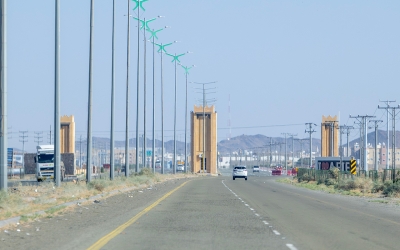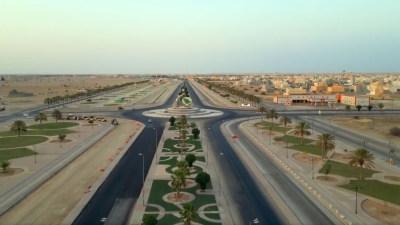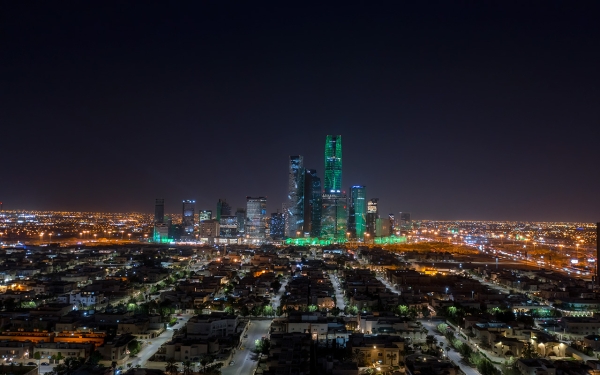
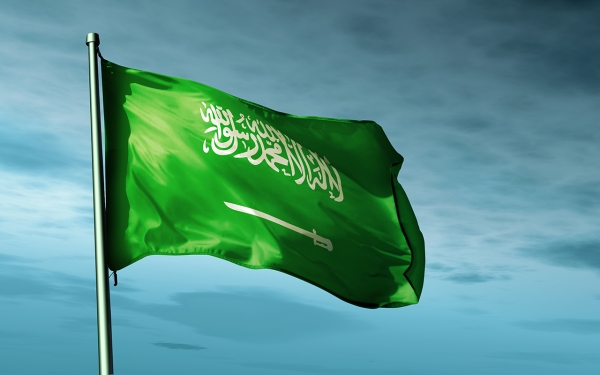
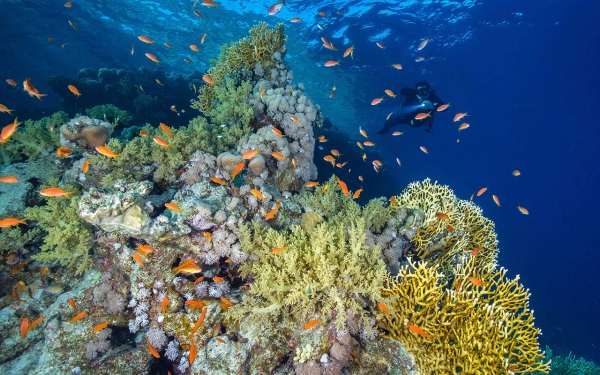
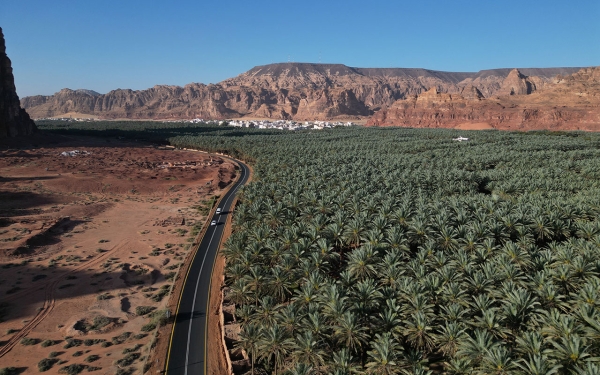
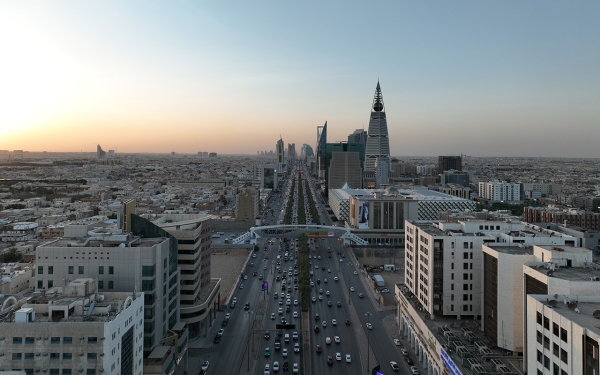
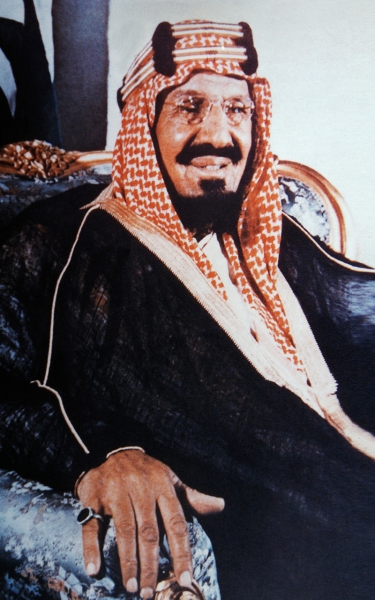
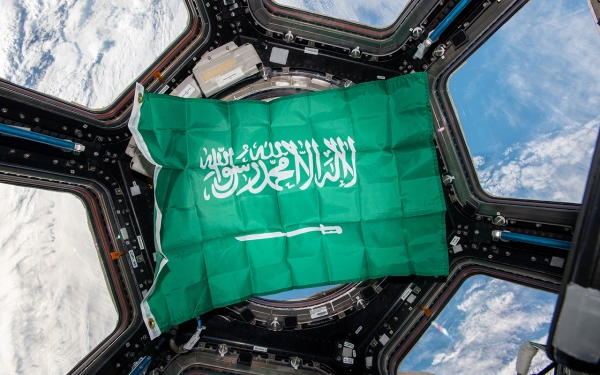
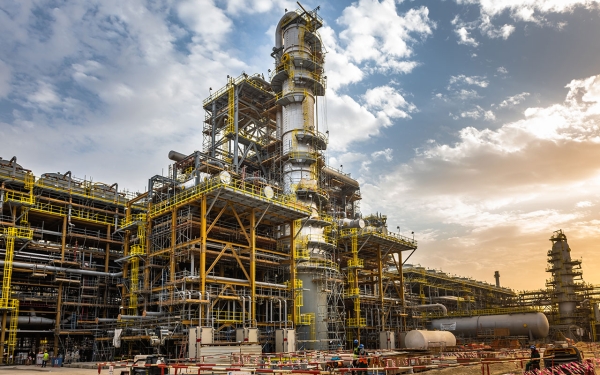
Saudi Arabia (officially the Kingdom of Saudi Arabia (KSA)) is an Arab Islamic state situated in the far southwest of the Asian continent. It is an extension of the rule of Al Saud family, which began with the First Saudi State founded by Imam Mohammed Bin Saud in the eighteenth century, and the Second Saudi State, established by the father of the Founding King Abdulaziz Bin Abdulrahman Al Saud and its last ruler, Imam Abdulrahman Bin Faisal, in 1891.
Saudi Arabia is bordered to the west by the Red Sea, to the east by the Arabian Gulf, the United Arab Emirates, and Qatar, to the north by Kuwait, Iraq, and Jordan, and to the south by Yemen and the Sultanate of Oman. The Kingdom is a sovereign state, its religion is Islam, its constitution is the Quran and the Sunna of the Prophet, Arabic is its language, and Its capital is Riyadh City.
History of Saudi Arabia
The history of Saudi Arabia is associated with the Arabian Peninsula, constituting its largest part. The modern history of Saudi Arabia began with the recovery of its capital, Riyadh, led by the Founding King Abdulaziz Bin Abdulrahman Al Saud, on January 15, 1902.
The early decades of the Kingdom's history were marked by the unification of various regions within the Arabian Peninsula, achieving stability, settling its Bedouin population, and fostering civilizational progress. This period coincided with World War I, yet Saudi Arabia managed to maintain its stability amid global conflicts.
Unification of Saudi Arabia
The unification of the regions and cities of Saudi Arabia spanned thirty-two years, beginning in 1902. Within a decade, King Abdulaziz Bin Abdulrahman Al Saud successfully regained control over southern Najd, Sudayr, al-Washm, as well as Qassim, al-Ahsa, Aseer, and Hail.
On September 19, 1932, a Royal Order unified the country and established it as the "Kingdom of Saudi Arabia". The announcement was made on Thursday, September 23, 1932, which was later designated as the National Day of the Kingdom.
The government of Saudi Arabia
Basic Law of Governance
The Basic Law of Governance is a set of fundamental principles and rules on which the state is established. It consists of eighty-three articles that detail the structural, organizational, and political foundations, such as the general principles of the state, the system of governance, the process for selecting the king, his duties, the foundations of Saudi society, and the rights of citizens and residents that the state guarantees and protects. It also outlines the powers of authorities and regulatory bodies. Issued by Royal Order in 1992, it may only be temporarily suspended in specific situations, such as during war or emergencies.
Law of Governance
The Basic Law of Governance in Saudi Arabia stipulates that the system of governance is a monarchy, limited to the sons of King Abdulaziz Bin Abdulrahman Al Saud and their descendants. The most suitable among them receives the pledge of allegiance. The King has the authority to appoint or dismiss his Crown Prince through a Royal Order, following consultations with the Allegiance Council. The law also stipulates that the Crown Prince devotes himself exclusively to his duties as Crown Prince and performs any duties delegated to him by the King. Upon the death of the King, the Crown Prince assumes the King's powers until a pledge of allegiance is given.
The King's duties
The law stipulated the duties of the King, including: supervising the implementation of the laws and general policy of the country, protecting and defending the country, and presiding over the Council of Ministers. The King is also the supreme commander of military forces. His duties include declaring states of emergency and war, taking any urgent measures in situations threatening the country's safety, territorial integrity, and the security and interests of its people and institutions, receiving kings and presidents of other countries, appointing representatives to other countries, and granting medals. The law also states that the King’s council and the Crown Prince’s council are open to every citizen and anyone with a complaint or grievance, and that every individual has the right to address public authorities.
Authorities of the state
The state authorities are composed of the following: the judicial authority, which is governed solely by Islamic Sharia; the executive authority; and the regulatory authority, which is tasked with setting laws and regulations.
State tasks
The law outlines the duties and responsibilities of the state, including: protecting the Islamic creed, maintaining the Two Holy Mosques, providing security for citizens and residents, protecting human rights, ensuring the rights of citizens and their families in emergencies, disability, illness, and old age, facilitating employment, promoting sciences, literature, and culture, providing public education and healthcare, establishing and equipping the armed forces, and protecting the environment.
General principles
The general principles of the Basic Law of Governance state that the Kingdom is a sovereign Arab Islamic State. Its religion is Islam. Its constitution is the Quran, and the Sunna of the Prophet. Arabic is the language of the Kingdom. The city of Riyadh is the capital. The Kingdom's public holidays are Eid al-Fitr and Eid al-Adha, and its calendar is the Hijri calendar.
The national flag
The national flag of the Kingdom is green, with its width two-thirds of its length, featuring the phrase "There is no God but Allah and Muhammed is the Messenger of Allah" in the center, with an unsheathed sword beneath it. The flag should never be lowered at half-mast. It is a national symbol of the Kingdom. Its history dates back to the founding of the First Saudi State in 1727. The current form of the flag was approved during the reign of King Abdulaziz in 1937. A Royal Decree issued during the reign of King Faisal Bin Abdulaziz Al Saud in 1973 approved its regulation as a national symbol.
The official emblem
The emblem of the Kingdom is two crossed swords with a palm tree positioned directly above the place where the swords cross.
National Anthem
It has been the official National Anthem of the Kingdom since 1984. It is the royal salute performed during celebrations, official receptions, and national occasions in the Kingdom. His lyrics were composed according to the principles on which the Kingdom was founded, which are:
Hasten to glory and supremacy, Glorify the Creator of the heavens
And raise the green flag, Carrying the written light reflecting guidance
Repeat: Allahu Akbar, O my homeland.
My homeland, Live as the pride of Muslims! Long live the King, For the flag and the homeland!
Council of Ministers
The Council of Ministers is the highest executive authority in the Kingdom. It operates from two main headquarters: one in the capital, Riyadh, next to al-Yamamah Palace, and another in Jeddah City, close to al-Salam Palace. These palaces also serve as venues for receiving state guests. Occasionally, the council holds sessions at other locations within the Kingdom.
The Council of Ministers is comprised of the Prime Minister, the Deputy Prime Minister, and various ministers. It is responsible for formulating state policies for public affairs and overseeing their execution.
Mandates of the Council of Ministers
The Council of Ministers undertakes monitoring the implementation of laws, regulations, and decisions, as well as establishing and organizing public interests. It oversees the execution of the general development plan and establishes committees to investigate the functioning of ministries and other government agencies, or specific issues. These committees present their findings to the council for review. The council may form committees to further investigate and make decisions, while adhering to the laws and regulations.
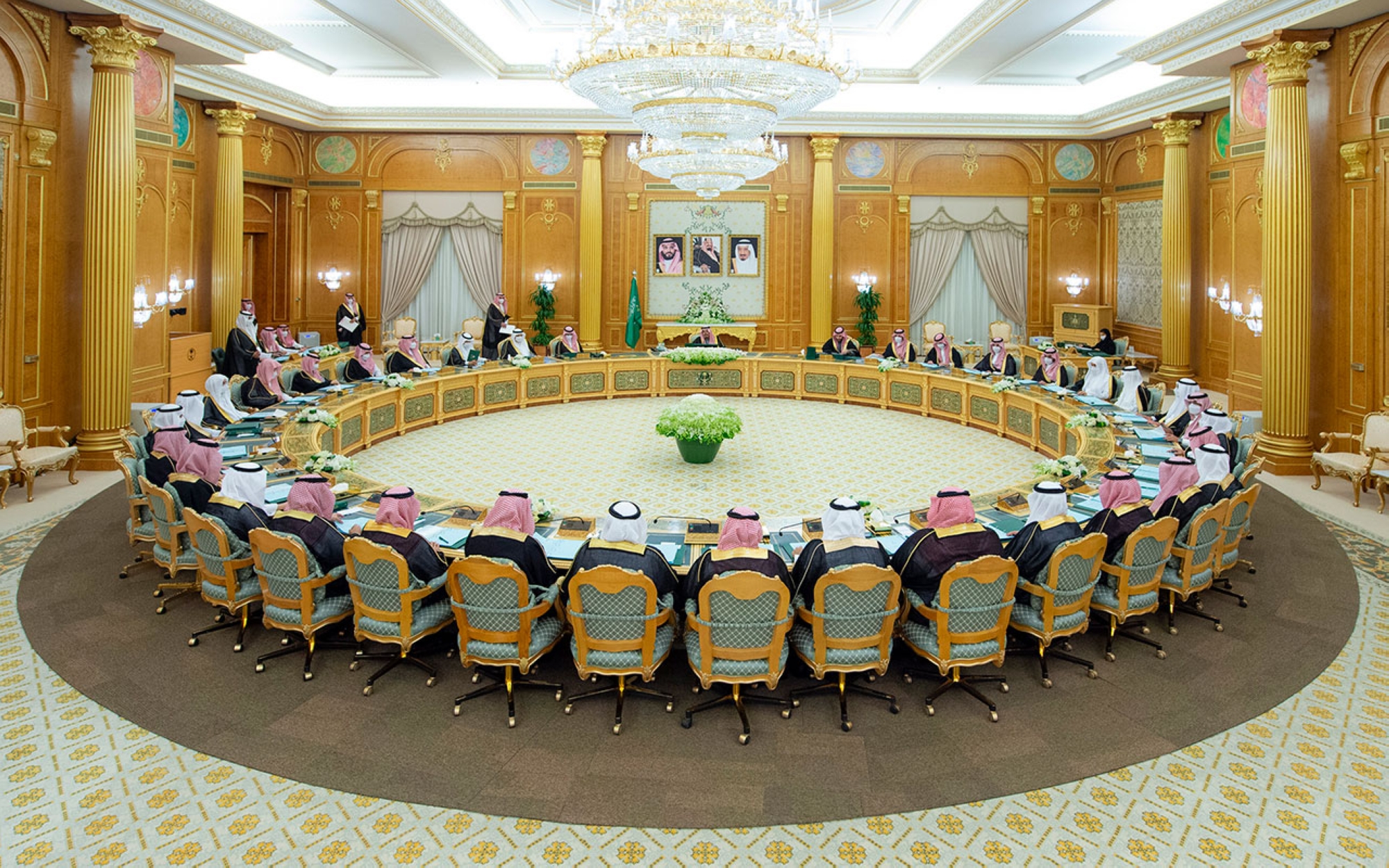
Shura Council
It is a regulatory governmental body based in Riyadh City. Originally known as the Consultative National Council, it was established before the completion of the Kingdom's unification in 1924 to manage the country's main administrative matters. The council was dissolved and then reconstituted in 1927, which is recognized as its official establishment date under its current name. King Abdulaziz inaugurated its first session on July 13, 1927.
The Shura Council has evolved through several stages to its present form, where it now reviews and advises on general state policies referred to it by the Prime Minister.
Activities of Shura Council
The council discusses the general plan for economic and social development, provides opinions on it, studies laws, regulations, treaties, international agreements, and concessions, and proposes what it deems appropriate regarding them. The council also discusses annual reports submitted by ministries and other government agencies, and proposes recommendations concerning them.
The Shura Council is authorized to propose a new law or amend an existing one and submit it to the King, as outlined in Article Twenty-Three of its law. Alongside the Council of Ministers, the Shura Council holds regulatory authority over the state, tasked with creating laws and regulations that serve the public interest, in accordance with the provisions and controls of Article Sixty-Seven of the Basic Law of Governance.
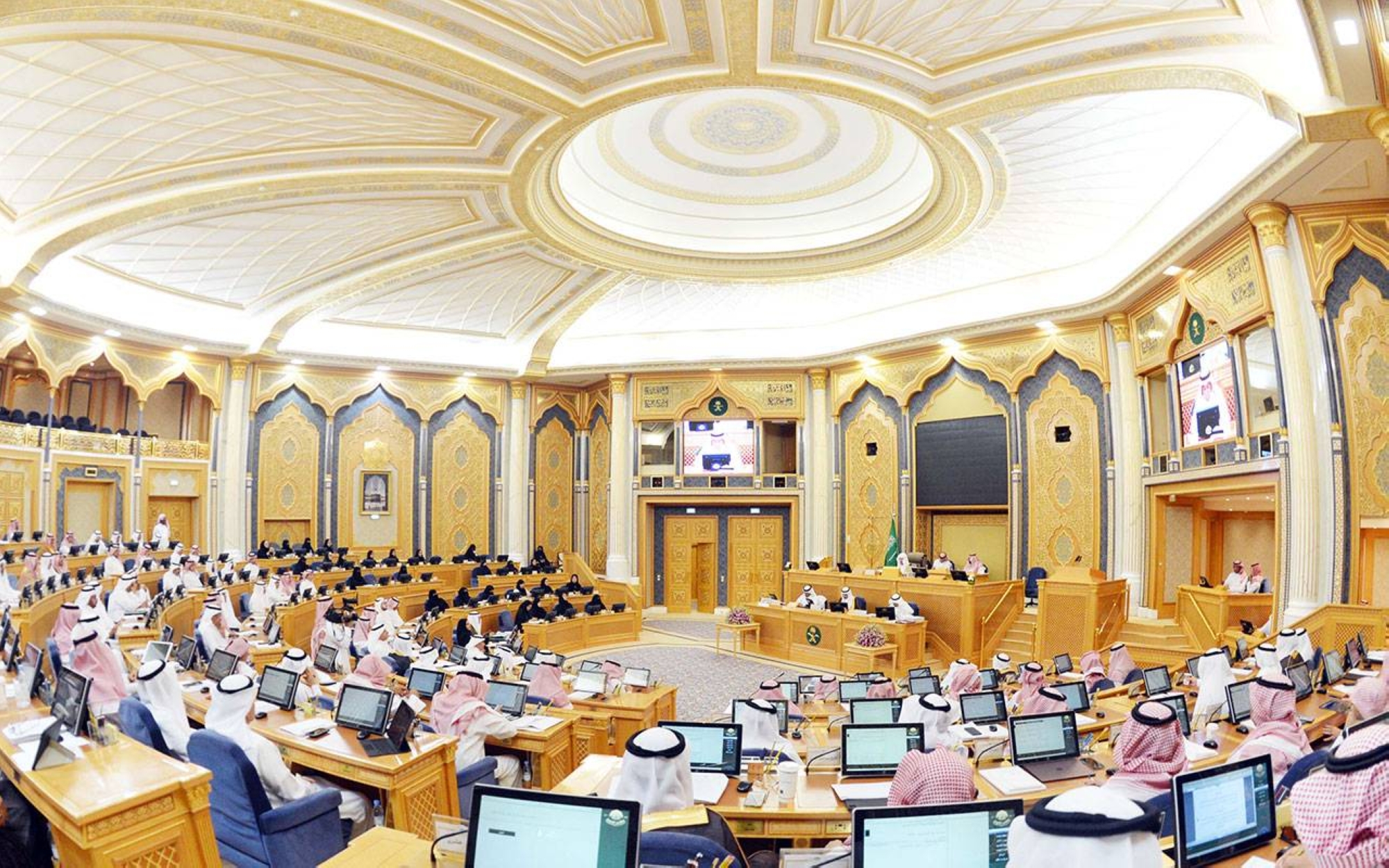
Ministries of Saudi Arabia
The Kingdom has twenty-four ministries, each responsible for implementing Saudi government policies, laws, and legislation. These ministries provide services, execute state programs, and lead in sovereign, economic, and service sectors. All ministries operate under the Council of Ministers and include:
Ministry of Foreign Affairs
The Founding King Abdulaziz Bin Abdulrahman Al Saud established the General Directorate of Foreign Affairs in Makkah al-Mukarramah in 1926. Then, in 1930, just two years before the announcement of the Kingdom's unification, King Abdulaziz issued a Royal Order to establish the Ministry of Foreign Affairs. This ministry was tasked with overseeing foreign policy, managing foreign diplomatic relations, attaining and safeguarding national interests, and enhancing the Kingdom's role in promoting security, stability, and prosperity both regionally and globally.
Ministry of Finance
The Ministry of Finance started as the Directorate of Public Finance for Financial Management, established in 1925 during the reign of King Abdulaziz. Due to the expansion of its work, it was then transformed to become the Public Financial Agency in 1928. However, after the development of its activities to manage the state's financial affairs, it was named the Ministry of Finance in 1932. The ministry is responsible for regulating and preserving the state funds, ensuring secure revenue and expenditure methods, and serving as the primary authority for financial matters across all provinces of the Kingdom.
Ministry of Defense
The Ministry of Defense was established in 1943, though its origins trace back to the reign of King Abdulaziz, who founded the Military Affairs Department in 1929. This department served as the precursor to the ministry. The Ministry of Defense is the entity tasked with planning and executing policies to safeguard the Kingdom's security, interests, and sovereignty, and it is responsible for protecting the Kingdom and deterring external threats.
Ministry of Interior
The Ministry of Interior was established during the reign of King Abdulaziz and started as the Public Prosecution in 1925. It remained as such until the issuance of the Agent Law in 1931 when it was transformed into the Ministry of Interior. The ministry's work developed in the domain of maintaining security, and its responsibilities expanded until it was re-established in 1951. It started to gradually supervise the provinces of the Kingdom until completed in 1961.
Ministry of Health
The Ministry of Health was founded during the reign of King Abdulaziz, beginning as the Public Health Department in Makkah al-Mukarramah in 1925. Later in 1925, the Directorate of Public Health and Ambulance was created. In 1951, a Royal Order established the Ministry of Health, entrusting it with the full responsibility for managing health affairs across the Kingdom, marking the start of widespread health reforms throughout all Saudi provinces.
Ministry of Transport and Logistic Services
The rapid growth of Saudi Arabia, following its founding, led to boosting the development process that required the establishment of the Ministry of Transportation in 1953 to supervise all aspects of transportation. In 1975, state ministries and public institutions were re-formed, and the Saudi Ports Authority and the Saudi Railways Organization were established. The ministry became responsible for planning, designing, constructing, and maintaining roads and bridges. The ministry was renamed the Ministry of Transport in 2003. Later, in 2021, a Council of Ministers resolution was issued to change the ministry's name to the Ministry of Transport and Logistic Services.
Ministry of Education
Saudi Arabia's commitment to education began early with the founding of the Directorate of Education in 1926, marking the cornerstone of the Kingdom's education system. The organization of the educational process and the expansion of schools continued until the Ministry of Knowledge was established in 1953. This was followed by the establishment of the General Presidency for Girls' Education in 1959. A Royal Decree was issued in 2003 to join the General Presidency for Girls' Education to the Ministry of Knowledge. The ministry's name was changed to the Ministry of Education one year later. In 2015, a Royal Order was made to join the Ministry of Education with the Ministry of Higher Education under the name of the Ministry of Education.
Ministry of Commerce
The Ministry of Commerce was established after King Abdulaziz directed the establishment of a Commercial Entity to settle traders' disputes (Traders Council) in 1927. The Law of Chambers of Commerce was issued in 1946 with the development of commercial activity. With the constant expansion of commercial activities and works, the Ministry of Commerce was established in 1954 to organize and develop internal and external commerce in general.
Ministry of Hajj and Umrah
The establishment of the Ministry of Hajj and Umrah traces its origins back to 1946, when the first General Directorate of Hajj was established under the Ministry of Finance. Its primary duties included providing services to pilgrims, establishing regulations to safeguard their rights and interests, and ensuring their well-being. As its responsibilities grew, the directorate evolved into the Ministry of Hajj and Endowments in 1961. In 1994, the endowment sector was separated, and the entity became known as the Ministry of Hajj. The name was further modified in 2016 to the Ministry of Hajj and Umrah.
Ministry of Media
Saudi media was first launched during the reign of King Abdulaziz by founding the Umm al-Qura Newspaper in 1924. Umm al-Qura was the cornerstone of the official Saudi media system. It publishes all matters issued by the state, whether Royal decisions, Orders, and Decrees, and official data. The ministry was established in 1963. In 2003, the culture sector was integrated into the ministry only to be separated again in 2018 to establish an independent Ministry of Culture.
Ministry of Investment
Established in 2020, the Ministry of Investment offers flexible and advanced services to both local and international companies, ranging from start-ups to large enterprises. Its mission is to foster an investment environment that is efficient and conducive to ease of business.
Saudi service to the Two Holy Mosques
The Grand Mosque in Makkah al-Mukarramah
It is the mosque that houses al-Kaaba al-Musharrafa, the Qibla for Muslims. It is the holiest site on earth for them, as they orient themselves towards it and face it during prayer, regardless of where they are. It derives its name, Masjid al-Haram, from the prohibition of combat within its grounds. Located in Makkah al-Mukarramah, it is directly overseen by the General Presidency for the Affairs of the Grand Mosque and the Prophet's Mosque. It is the oldest mosque in the world and the largest in terms of area and capacity, with a total area of approximately 1.5 million m and a capacity estimated at three million worshipers.
It is connected to the Hajj and Umrah rites. The reward for praying in it is multiplied by one hundred thousand times compared to other mosques. It also houses several religious landmarks such as Maqam Ibrahim, the Black Stone, and Zamzam Well. The region around it is known as the central area, which encompasses the Mataf courtyard within it.
The Kingdom provides a range of services for visitors to the Grand Mosque, including navigation programs to assist with directions and identify facilities, phone charging stations for visitors and pilgrims, sermon translation services, Braille copies of the Quran for the visually impaired, electric carts for the elderly, guides to address pilgrims’ questions, designated areas for lost individuals, offices for lost and found, health centers, and a hospital specifically for visitors and pilgrims.

The Prophet's Mosque in al-Madinah al-Munawwarah
It is the Mosque of Prophet Muhammed, peace be upon him (PBUH), the best mosque after the Grand Mosque, the second of the Two Holy Mosques, and the second most sacred religious site for Muslims after the Grand Mosque. The Prophet's minbar and mihrab (where the Imam stands to lead the prayer) lie in the Prophet's Mosque. It is associated with the tombs of the Prophet Muhammed (PBUH) and his two companions, Abu Bakr and Umar Ibn al-Khattab (May Allah be pleased with them).
The Prophet’s Mosque received great care from the Kingdom, as expansion, maintenance, and development activities extended from the era of the Founding King Abdulaziz Al Saud until this day. To make it easier for visitors to access and worship at the Prophet's Mosque, various electronic services have been made available.
The General Presidency for the Affairs of the Grand Mosque and the Prophet's Mosque (currently the General Authority for the Care of the Affairs of the Grand Mosque and the Prophet's Mosque) was established by Royal Decree in 1977. This decree also led to the establishment of the Agency for the Affairs of the Prophet's Mosque, which is responsible for managing all religious and service-related activities. The agency ensures that visitors can perform their worship and rituals in a safe and enlightened environment while fulfilling the spiritual and educational mission of the Two Holy Mosques.

Economy in Saudi Arabia
History of economy in Saudi Arabia
The history of the Saudi economy is associated with the discovery of oil in the Kingdom during the era of the Founding King Abdulaziz Bin Abdulrahman Al Saud, in 1939, marking the first operation of a Saudi oil well.
The Saudi economy underwent a foundational and construction phase from the unification of the Kingdom until 1969, which set the stage for the subsequent development planning phase. Following this, the Saudi economy entered a new phase characterized by development planning. Until 2014, its performance was driven by two main factors: the level and growth of oil revenues, and government spending policies.
During that period, the national economy experienced several economic cycles beginning in 1970, which marked the start of the modern renaissance of the Saudi economy with the introduction of five-year development plans. The price of oil per bbl quadrupled, leading to a substantial increase in oil revenues. This surge in revenue prompted a series of successive spending increases, which accelerated the pace of economic growth.
However, the prosperity phase linked to these development plans gave way to stagnation starting in 1982, due to a slowdown in annual oil production growth and falling oil prices, which reduced oil revenues.
The Saudi economy began to recover in 2003, with an average annual growth rate of real gross domestic product (GDP) reaching 5 percent and financial surpluses being achieved.
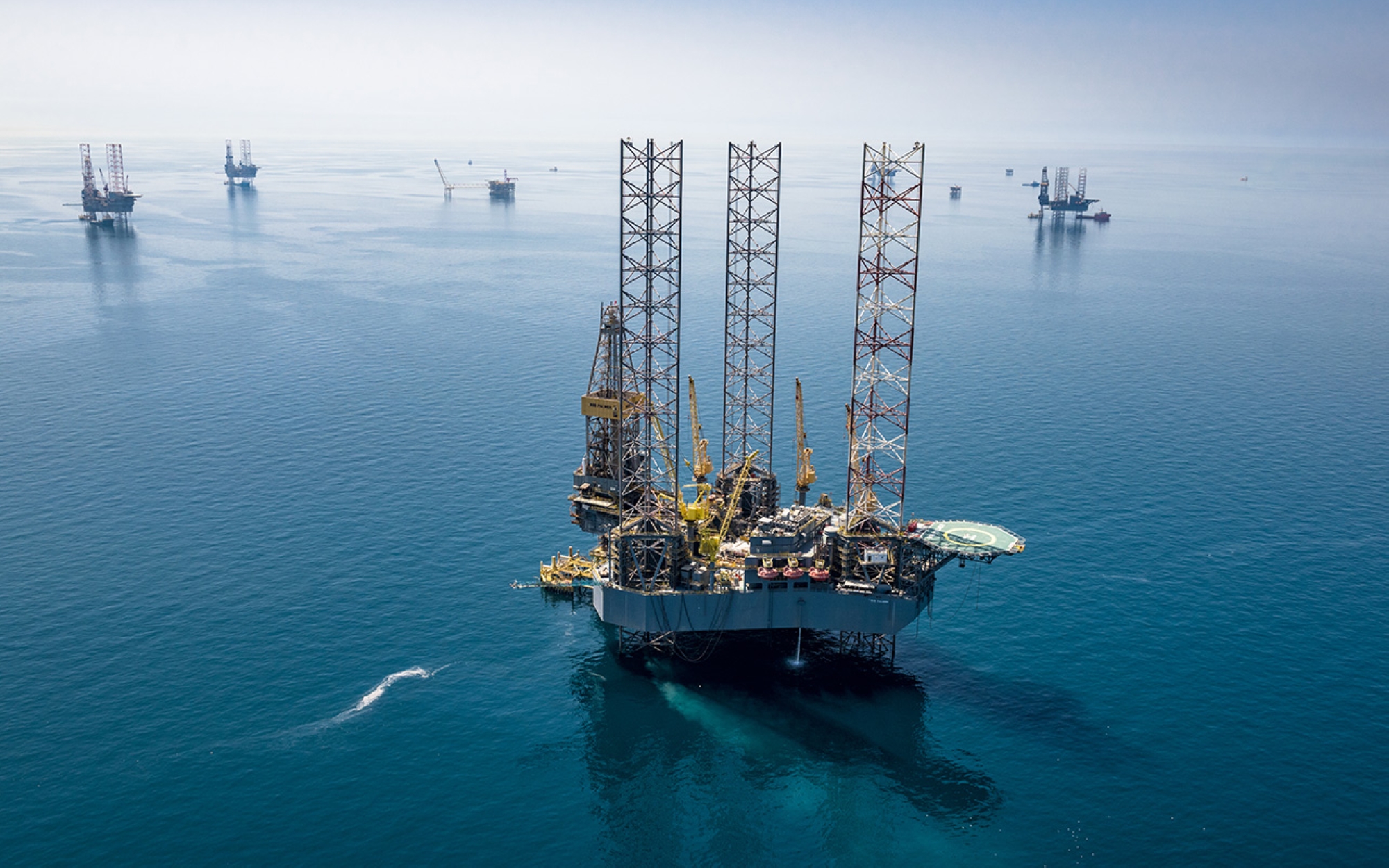
Economic development in Saudi Arabia
Economic development in the Kingdom is influenced by various economic and non-economic factors. The Kingdom boasts a rapidly growing economy, ranked among the strongest in the Middle East. Its strategic location enhances its international standing as a key player in global trade, serving as a link between Asia, Europe, and Africa. The Kingdom has established itself as an economic powerhouse and the world’s largest oil exporter. Additionally, it is the most populous and economically robust nation in the Gulf region.
Five-year development plans
Since 1970, the Kingdom has been formulating five-year development plans. These plans primarily focus on bolstering national defense and enhancing internal security and stability in the Kingdom. They also aim to achieve high economic growth by optimizing the use of economic resources and maximizing oil revenues over the longest possible duration, all while preserving depletable resources. The plans seek to diversify the economy by reducing reliance on crude oil exports, expanding the production base, and improving human resources through enhanced education and training. Additionally, they emphasize raising health standards, increasing societal welfare, and supporting social stability amidst rapid changes. Finally, the plans include building essential infrastructure to achieve these overarching goals.
Saudi Vision 2030
Saudi Vision 2030, introduced in 2016 by His Royal Highness Prince Mohammed Bin Salman Bin Abdulaziz, crown prince and prime minister, represents a modern approach to development planning. It redefined the planning development concept through new frameworks and adopted an interactive approach, moving away from the traditional methods used in earlier plans since the 1970s. The vision is built on three core pillars that encompass not just economic development but also aspects such as lifestyle, living standards, natural resources, energy, workforce, and overall societal and economic progress. It aims to strengthen the economic structure and transition toward a diverse and sustainable economy.
The first pillar of the vision focuses on creating a vibrant society as a foundation for economic success. The second pillar aims to establish a thriving economy by generating job opportunities for all and aligning the educational system with labor market needs. The third pillar emphasizes building an ambitious nation through an effective government, enhancing efficiency, fostering a culture of performance, and empowering both energy and human resources.
To realize the vision's objectives, the Kingdom has launched several transformative and executive programs, such as the National Transformation Program 2020, which focuses on developing infrastructure and creating a supportive environment for public, private, and non-profit sectors to achieve vision objectives. Another initiative is the Fiscal Balance Program 2020, aimed at improving financial management and restructuring the Kingdom's financial landscape.
The vision has targets by 2030, including: elevating the economy to be among the top fifteen globally, increasing non-oil exports to at least 50 percent of non-oil GDP, advancing the Kingdom's rank in the Logistics Performance Index to twenty-fifth globally and first regionally, having the private sector contribute 65 percent to the GDP, and achieving a top ten position in the Global Competitiveness Index.
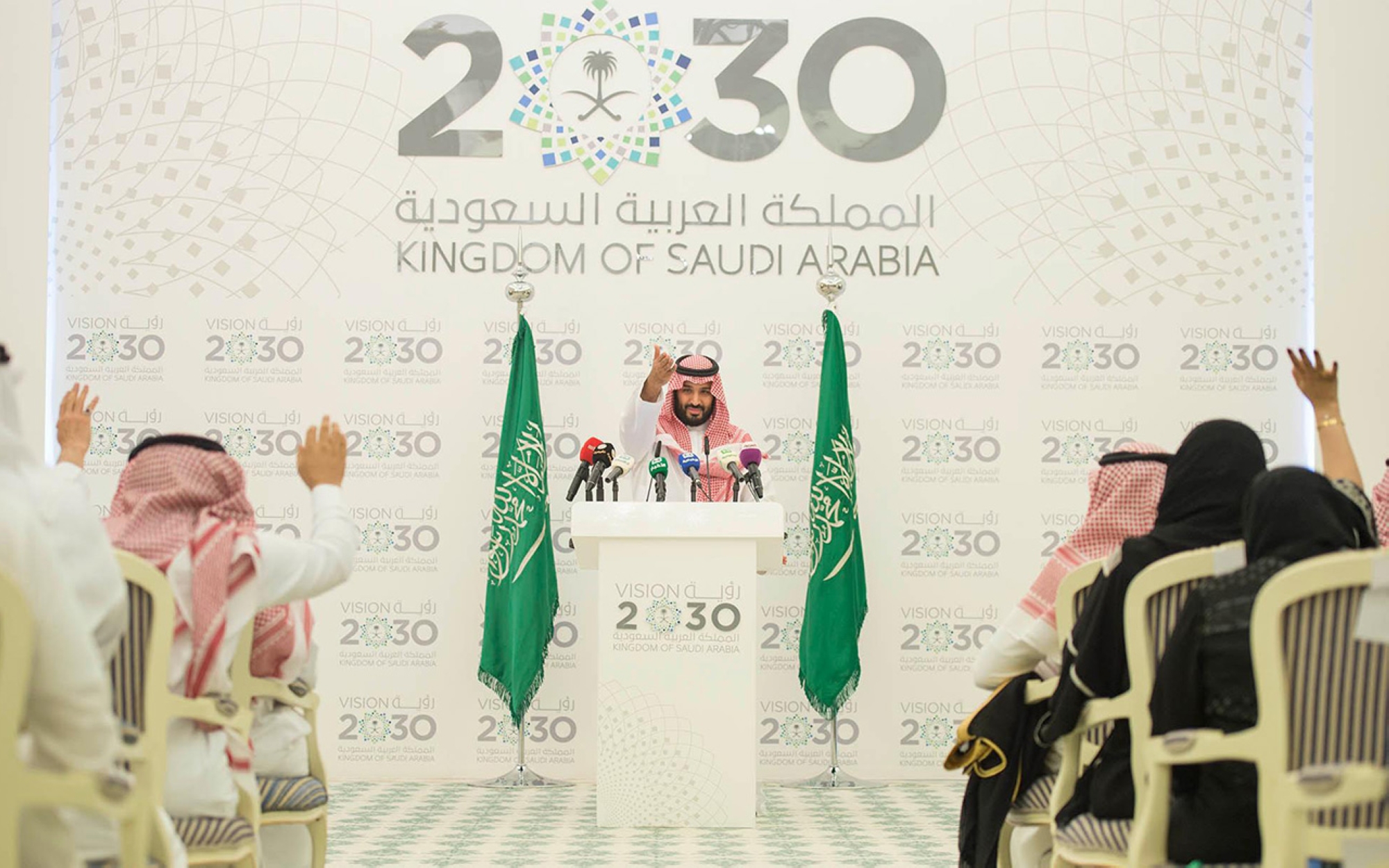
Natural resources in Saudi Arabia
Oil is a vital natural resource for the Kingdom, which boasts the world's second-largest oil reserves and ranks second globally in the top ten countries for natural resource reserves, valued at approximately SAR129 trillion (USD34.4 trillion).
The Kingdom’s geological diversity has resulted in a wealth of natural resources, including gold, silver, copper, zinc, phosphate, and natural gas.
The Kingdom is the sixth-largest gas market worldwide, with a peak natural gas production rate of 10.8 billion standard ft per day and a reserve of twenty-five billion bbl of natural gas liquids, equivalent to 194.5 trillion standard ft of natural gas as of 2021. As of 2019, there are around 510 sites and 138 fields for extracting and processing associated and non-associated natural gas, including unconventional sources.
Since the discovery of oil in commercial quantities in Dammam City, east of the Kingdom, in 1938, natural resources have significantly boosted local prosperity. The increased production and number of wells have made the oil sector a major economic driver for the Kingdom.
Mining in Saudi Arabia
Mining is one of the most prominent economic sectors in the Kingdom, and the third pillar of its national economy. The Kingdom ranks thirteenth globally for its rich and diverse mineral resources, with over forty-eight types identified, including around fifteen that are economically viable for exploitation.
The Kingdom possesses the world's largest reserves of phosphate and tantalum and leads the Middle East in gold production, reaching approximately four hundred thousand oz in 2019. The central and northern regions are rich in bauxite ore, and also contain significant quantities of silver, zinc, copper, magnesium, and kaolin.
The Kingdom is taking several steps to explore its mineral resources, including: providing essential geoscience data and technical information digitally, intensifying preliminary exploration and aerial surveys, establishing exploratory incubators to assist small and medium-sized companies in contributing to exploration activities, initiating detailed exploration operations, with a primary role for local and international private sectors, accelerating mineral ore exploration through a program designed to support experienced companies, attract global expertise, and train Saudis, in addition to developing the Mining Investment Law and speeding up the licensing process.
According to the preliminary estimates of the Ministry of Industry and Mineral Resources for 2020, gold production reached approximately 13,222 kg, silver production reached about 7,479 kg, and the Kingdom's production of copper concentrates increased to 92,915 t during the same year. Zinc production amounted to approximately 54,448 t.
Regarding other mineral ores, the total amount extracted in 2020 was estimated to be over 514,756 t of various mineral ores such as limestone, silica sand, salt, clay, feldspar, marble for industrial purposes, iron sand, kaolin, gypsum, marble blocks, granite, limestone, phosphate, bauxite, crusher materials, and ordinary sand used in construction and building works.
The Ministry of Industry and Mineral Resources has implemented a set of initiatives to improve and develop the mining sector in the Kingdom, including: launching the new Investment Law, establishing mining services companies, signing contracts for the General Program for Geological Survey, and inaugurating the National Geological Database, which contains information on about 5,500 mineralized sites, geological survey, and exploration data spanning eighty years, and ten thousand technical reports. Additionally, fifty-four mining reserve sites have been designated.
The ministry also launched the Ta'adeen platform in 2019, aiming to provide licensing services to investors. In fact, 150 licenses have been issued, and 550 investors have been registered. The time required to renew licenses has been reduced from sixty to seven days, with the possibility of further reducing the renewal time to one day after integration with banks.
Industry in Saudi Arabia
It is an industrial sector that has had a significant impact on the non-oil GDP of the Kingdom. The national push towards industrialization began early in the Kingdom’s history, evident from the efforts of the Arab Savings and Economy Company in Makkah al-Mukarramah, which produced military uniforms as early as 1936.
Industrial activity continued to expand in the 1950s, driven by the government's pro-industry policies. This led to the advancement of industry in the Kingdom. Companies benefited from exemptions on customs duties for precision machinery, factory equipment, and other industrial tools. Additionally, the government supported industry owners in their efforts to achieve self-sufficiency.
With the onset of the implementation of development plans, industry began to explore new opportunities, marking the 1970s as the dawn of modern Saudi industrial history.
Factories operating in Saudi Arabia
Over the past thirty years since the initial development plan, the industrial sector has made significant strides. The number of factories operating in the Kingdom surged from 199 in 1970-1971, with total investments of SAR2.8 billion, to 3,123 factories in 1998-1999, with total investments reaching SAR230 billion.
Saudi Industrial Development Fund
The Kingdom has focused on strengthening its industrial sector as a key driver of development. Leveraging its resources and manufacturing capabilities, the country has advanced to become an industrial development hub. In 1974, the Council of Ministers established the Saudi Industrial Development Fund to enhance industrial investment opportunities, advance local industry, and improve performance levels.
The fund has contributed to the qualitative and quantitative advancement of the Saudi industrial sector, boosting its competitiveness by achieving the objectives, policies, and programs of industrial development in the country. This includes providing medium- to long-term loans for establishing new factories, modernizing and expanding existing ones, and offering administrative, financial, technical, and marketing consultations to industrial facilities across the Kingdom.
The Saudi Authority for Industrial Cities and Technology Zones "MODON"
The Kingdom has pursued the creation of a robust framework to foster industrial activity development. Alongside the ministry and the industrial fund, the Saudi Authority for Industrial Cities and Technology Zones (MODON) was founded in 2001 to enhance industrial lands and integrated infrastructure. MODON oversees thirty-six operational industrial cities and several others under development across the Kingdom, as well as private industrial complexes and cities.
MODON's strategy facilitates industrial expansion across all fields and investment opportunities for all investors, leading to the development of approximately 198.8 million m of industrial land. Currently, these industrial cities house 3,600 factories and have 6,301 industrial, service, and logistics contracts.
National Industrial Strategy
In line with the country's efforts to develop the industrial sector and operate within a regulatory framework that fosters growth and maintains the competitiveness of national industrial products and services, the Council of Ministers adopted the National Industrial Strategy in 2009. This strategy set the course for industrial development through to the end of 2020.
It established goals for the national industry over a ten-year period, aiming to double the added value of industry, increase its contribution to the GDP to 20 percent, raise the share of technically based manufactured products in total industrial production from 30 percent to 60 percent, and boost the share of industrial exports in total industrial production from 18 percent to 35 percent during the strategy period.
The strategy focused on specific industries within modern industrial clusters, including five core industries that form the nucleus of the Industrial Clusters Program. These industries are automotive and parts manufacturing, metals processing, general-purpose machinery manufacturing, building materials manufacturing, and plastic packaging manufacturing.
National Industrial Development and Logistics Program
With the launch of the programs and initiatives of Saudi Vision 2030, the industrial sector has taken a more effective and advanced path. The National Industrial Development and Logistics Program (NIDLP) was launched at the beginning of 2019 to transform the Kingdom into a leading industrial power and a global logistics hub. The program aims to maximize value in the mining and energy sectors, with a strong focus on local content and the Fourth Industrial Revolution.
The program includes four pivotal sectors, including national industries, logistics services, mining, and energy, and contributes to achieving integration between them in order to achieve maximum added value from them, enhance and diversify their economic impact, in addition to creating an attractive investment environment, while taking care of the two axes of local production and the Fourth Industrial Revolution.
Since its launch, NIDLP has successfully achieved several of its goals in developing the national industry. Notable accomplishments include the launch of the Geological Survey Program, significant progress in the Maritime Navigation Network Connectivity Index with global shipping lines, the inauguration of the first locally manufactured fast interceptor boat, the establishment of renewable energy stations, a rapid increase in investment in the industrial sector, support for the localization of the military industries sector, and the launch of the "Made in Saudi" program.
The program continues to enhance the economic impact of Saudi industries by contributing to increasing its competitiveness and its attraction as an ideal destination for investment, in addition to optimizing the use of all resources, improving policies and legislation relevant to the sector, thus allowing it to achieve its goals, as well as empowering local and foreign private sector investments. It also improves the trade balance and creates a local industry that is able to compete in global markets, in addition to creating sustainable competitive advantages based on innovation, stimulating investments, and creating job opportunities.
Made in Saudi program
The industrial sector benefits from increased institutional support through the Saudi Export Development Authority. In 2021, the authority, in collaboration with its partners in the industrial system, launched the "Made in Saudi” program. It constitutes a national program for every Saudi, as part of mega initiatives launched by the Kingdom to bolster and advance the capabilities of the national industry. The program has contributed to the rise in non-oil GDP and non-oil exports, which totaled approximately SAR318 billion by the end of 2019.
The "Made in Saudi" Program contributes to the realization of the goals of Saudi Vision 2030 in the industrial sector, playing a major role in promoting local products and enabling Saudi products to compete locally, regionally, and globally. It also supports the efforts exerted to increase Saudi non-oil exports from 16 percent to 50 percent of the non-oil GDP by 2030.
The "Made in Saudi" program is supported by a number of national institutions that contribute to its success. The Saudi Center for International Strategic Partnerships, which specializes in unifying the Kingdom's efforts in its international partnerships, supports the program by helping it reach global markets and collaborating in organizing seminars, conferences, and workshops.
"Made in Saudi" continues to achieve its strategic objectives of strengthening the Kingdom's industrial value by increasing private sector participation from 40 percent to 65 percent, boosting foreign direct investment in the GDP from 3.8 percent to an international average of 5.7 percent, and helping to create more than 1.3 million job opportunities in the industrial and mining sectors.
The program also aims to expand into international markets by promoting high-quality Saudi industries. To date, around ten thousand factories have been established with investments totaling SAR1.115 trillion, resulting in a broad global presence, with Saudi products reaching 178 countries worldwide.
The Saudi industrial sector has demonstrated its resilience in the face of challenges and economic fluctuations, such as during the COVID-19 pandemic in 2020. Despite the crisis, 903 factories were licensed, attracting investments exceeding SAR23 billion, and creating 39,000 jobs, the majority of which were for Saudi male and female citizens. Additionally, 515 factories commenced operations during this period.
Currency of Saudi Arabia
It is the official currency adopted in the Kingdom, abbreviated as the Saudi Riyal to distinguish it from the currencies of other countries. Foreign exchange traders and central banks worldwide denote it as 'SAR'.
Before the entry of the Founding King Abdulaziz Bin Abdulrahman Al Saud into the city of Riyadh in 1902, the Kingdom existed in a disorganized state regarding monetary transactions. Saudis utilized various methods in their monetary dealings, including bartering—where goods were exchanged directly—alongside the use of diverse foreign currencies. These included the Austrian Taler, commonly referred to locally as the 'Maria Theresien Dollar', 'al-Riyal al-Fransi' (the French Riyal), made of copper-nickel alloy and particularly prevalent and used by people at the time, and the British Pound, known colloquially as 'Jineah George' (George's Guinea).
Issuances of paper currency in Saudi Arabia
Over the past decades, the Kingdom has issued six issuances of paper currency and introduced various forms of money. During the reign of King Saud, the first official paper currency issue was issued in denominations of SAR100, SAR50, SAR10, SAR5, and SAR1, on April 16, 1961. Ten years after the issuance of the first paper currency, the government withdrew said issuance from the markets on June 24, 1971.
Since the third issuance, images of the Kingdom's kings have been included, while the first two editions featured various Saudi landmarks, such as the Two Holy Mosques, Jabal al-Nour in Makkah al-Mukarramah, the Council of Ministers building, al-Masmak Palace, the gate of al-Nasiriya Palace, and an oil refinery.
The Saudi currency, in its early days, was tied to the appearance of foreign coins made of copper-nickel. The new coins at that time featured the name and title of King Abdulaziz (King of the Hejaz and Sultan of Najd), engraved in marginal writing on the denominations' faces.
Due to the absence of a central Saudi monetary authority, the Kingdom minted its currency abroad and imported it in batches. This situation led to a decline in the exchange value of the Saudi silver riyal, causing a significant discrepancy between the SAR’s market value and its worth as a metal in the global market. To address this, King Abdulaziz ordered the establishment of the Saudi Arabian Monetary Agency (SAMA) (now the Saudi Central Bank) on April 20, 1952, to regulate monetary conditions.
In celebration of the centennial anniversary of the founding of the Kingdom on 5 Shawwal 1998, the Kingdom issued two new currency denominations: the SAR200 and SAR20 notes, both featuring the anniversary's logo. In its latest currency issuances (the fifth and sixth), the Kingdom incorporated security features to help ensure the authenticity of its currency and protect against counterfeiting.
Unlike the previous five currency issuances, which bore the signatures of both the Minister of Finance and the governor of SAMA, the sixth issuance during the era of King Salman featured the signature of the Minister of Finance on all paper currencies, except for the SAR5 polymer note, which displayed only the name of the SAMA governor without any signatures.
The sixth currency issuance introduced thirteen currencies, including six paper notes: the SAR5 note (featuring King Salman and an image of the Shaybah field in al-Rub' al-Khali (the Empty Quarter), the SAR10 note (depicting King Salman and al-Murabba Palace in Riyadh), the SAR50 note (showing King Salman, the Dome of the Rock Mosque, and a view of al-Aqsa Mosque on the back), the SAR100 note (displaying King Salman, the Green Dome of the Prophet’s Mosque, and a view of the Prophet’s Mosque in al-Madinah al-Munawwarah on the back), the SAR200 note (featuring King Abdulaziz and the Saudi Vision 2030 logo in 3D on the front, with a picture of al-Hukm palace in Riyadh on the back), and the SAR500 note (depicting King Abdulaziz and al-Kaaba al-Musharrafa, with a view of the Grand Mosque in Makkah al-Mukarramah on the back). Additionally, there were seven coins: the 1-halalah, 5-halalah, 10-halalah, 25-halalah, and 50-halalah coins, all featuring the state emblem, while the SAR1 coin shows King Salman, and the SAR2 coin features King Abdulaziz.
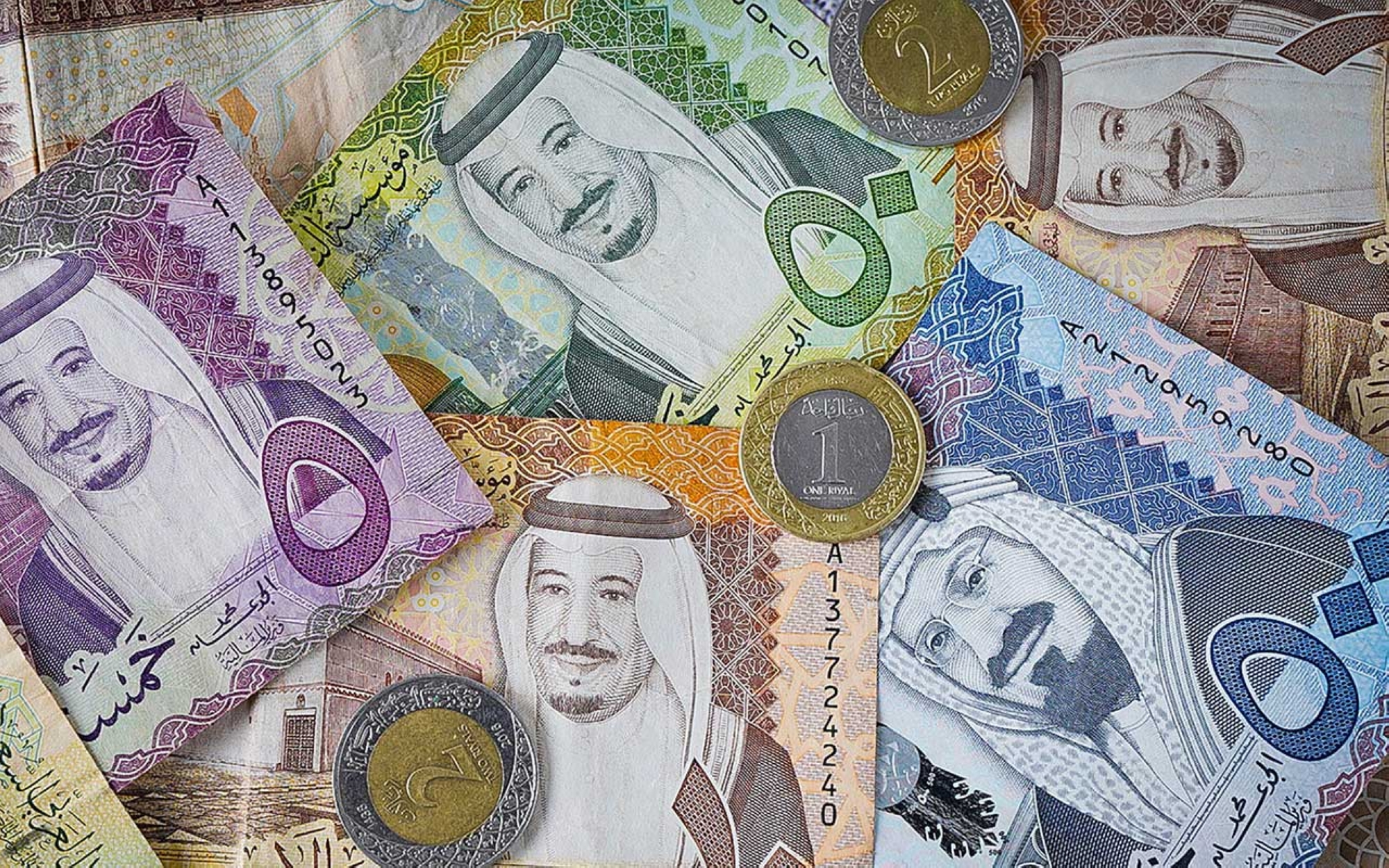
Trade in Saudi Arabia
The trade sector in Saudi Arabi
The trade sector in the Kingdom is a growing sector that combines the commercial exchange of goods, services, and capital between individuals and commercial and legal entities, to meet needs or achieve economic goals.
Trade plays a crucial role in the Kingdom's GDP, which reached SAR2.974 trillion (approximately USD793 billion) in 2019, marking a 0.8 percent growth over 2018. Crude oil and natural gas contributed at 27.4 percent, government services at 19.4 percent, and wholesale and retail trade, restaurants, and hotels at 10.0 percent, equating to about USD79.29 billion.
In 2019, the Kingdom's foreign trade exports totaled SAR981.012 billion, with mineral products accounting for the largest share. The Kingdom also ranked twenty-first in the global e-commerce market among the thirty strongest markets worldwide.
Strategically located, the Kingdom serves as a commercial hub connecting Africa, Europe, and East Asia, with access to key maritime trade routes. For thousands of years, the region's inhabitants have been active in global and regional trade, with the historic Silk Road passing through its ports and lands.
The Kingdom's commercial significance is further bolstered by its diverse terrain, which supports a varied local economy, including crude oil and its derivatives, minerals, industries, and food production.
The Kingdom has joined international organizations and signed agreements aimed at facilitating trade exchange operations, boosting the sector for economic gains, and achieving parity in global trade. In 2005, after twelve years of negotiations, the Kingdom became a member of the World Trade Organization (WTO), which regulates the trade exchange of goods and services. It obligates its members to adhere to sixty international trade provisions and regulations, which protect commercial intellectual property rights and resolve trade disputes.
The Saudi Business Center was established as an initiative to enable individuals to start a business within a single day through a unified platform that provides all services.
The Kingdom's e-commerce activity has emerged as the largest market in the Middle East, valued at SAR29.7 billion, with thirty-two million internet users recorded by 2020. Despite being relatively new, this sector has outpaced traditional trade, leading the Kingdom to rank among the top ten most advanced countries in the United Nations e-Commerce Index.
In 2019, the e-Commerce Law was enacted, followed by the establishment of the e-Commerce Council, which launched thirty-nine initiatives aimed at supporting the growth and enhancement of the e-commerce sector in the Kingdom.
Commercial Law in Saudi Arabia
The Commercial Law in the Kingdom is intricate and closely linked to various other sectors, responding directly to any changes within them. It is overseen by the Ministry of Commerce.
The logistics sector serves as the backbone and key driver of trade, with the Saudi logistics market valued at SAR70 billion. This sector encompasses seaports managing 240 million t of goods annually, twenty-seven airports handling 1.5 million t of air freight, and over two hundred thousand km of land routes, including 1,700 km of railways facilitating the transportation of goods to and from ports.
The first trademark registered in Saudi Arabia
The first trademark registered in the Kingdom was Kibrit al-Shaala (al-Shaala Matches) in 1945, eight years prior to the establishment of the Ministry of Commerce. The Kingdom laid the groundwork for global leadership in oil exportation in 1938, around the time when oil began to be produced in commercial quantities. Today, Aramco stands as the sixth largest company in the world.
Gold trade in Saudi Arabia
The gold markets in the Kingdom offer a variety of items beyond just pure gold, including plated pieces and those inlaid with precious or artificial stones. Gold shops also feature bullion in the form of coins, as well as items made from platinum and silver, which are among the most valuable metals and are often incorporated into modern designs. The karat of gold indicates its purity; the higher the karat, the purer the gold. Merchants are required to disclose the percentage of any additional metals or stones in a piece. Buyers are entitled to a detailed description of the item, the jeweler’s stamp, and information about the karat.
The judiciary in the Kingdom of Saudi Arabia
The judiciary in Saudi Arabia
It is one of the three authorities in the Kingdom, alongside the executive and regulatory authorities. This independent authority operates under the supervision of the Ministry of Justice. The first judicial presidency was established on February 7, 1926, during the reign of the Founding King Abdulaziz Bin Abdulrahman Al Saud, in the western region of Makkah al-Mukarramah. According to Article Fifty of the Basic Law of Governance, the implementation of judicial rulings falls under the responsibility of the king or his representative.
Saudi judiciary ranking globally
According to the 2019 Global Competitiveness Report from the World Economic Forum (Davos) in Geneva, the Kingdom secured sixteenth place globally in the "Judicial Independence Index", moving up eight positions from the previous year. The country also improved its ranking in the "legal framework efficiency index for dispute resolution", reaching seventeenth place, up four spots. In the "efficiency of the legal framework in challenging regulations" indicator, the Kingdom advanced eleven places to eighteenth globally. Additionally, it maintained its eleventh place ranking in the "legal framework's adaptability to digital business".
Supreme Judicial Council
It is the highest judicial authority in the Kingdom. According to the Saudi Law of the Judiciary, the council is responsible for issuing regulations related to the functional affairs of judges after obtaining the King's approval and the appointment, promotion, discipline, delegation, lending, training, transfer, leave, and termination of services of judges, among others. Additionally, the council's responsibilities include establishing, merging, or abolishing courts and issuing judicial inspection regulations.
Geography of Saudi Arabia
Saudi Arabia's location
The Kingdom holds a strategic geographical location at the heart of three continents: Asia, Africa, and Europe. Specifically, the Kingdom is situated in the far southwest of the Asian continent. It is bordered to the west by the Red Sea, to the east by the Arabian Gulf, the United Arab Emirates, and Qatar, to the north by Kuwait, Iraq, and the Hashemite Kingdom of Jordan, and to the south by Yemen and the Sultanate of Oman.
Population census
The population of the Kingdom stands at 32,175,224 people. Of this total, 18.8 million are Saudi nationals, accounting for 58.4 percent, while 13.4 million are non-Saudis, making up 41.6 percent. The male population is 19.7 million, or 61 percent, while females total 12.5 million, representing 39 percent. Riyadh, Makkah al-Mukarramah, and the Eastern Province together comprise 68 percent of the population. Among Saudi cities, Riyadh is the largest by population, followed by Jeddah, Makkah al-Mukarramah, al-Madinah al-Munawwarah, and Dammam.
Waterfronts
The Kingdom boasts three seafronts, with coastlines extending approximately 3,800 km. One of these seafronts lies along the Red Sea, while the remaining two are situated along the Arabian Gulf and the Gulf of Aqaba. It overlooks both the Gulf of Aqaba and the Red Sea from the west, with a coastline spanning approximately 2,600 km. This includes around 180 km along the Gulf of Aqaba coast. The Kingdom holds the top position among countries flanking both sides of the Red Sea when it comes to the length of its coastline. Around 80 percent of the eastern coast of the Red Sea falls within its borders.
Saudi Arabia's area
The Kingdom commands the largest area among the countries of the Arabian Peninsula, encompassing over two million km. This region displays terrain diversity, featuring narrow plains along the Red Sea coast (Tihama Plains). Progressing eastward, there are mountain ranges traversing the Kingdom's length. Subsequently, the central region encompasses deserts and rocky plateaus (accounting for 90 percent of the overall area). An-Nufud Desert is the largest to the north and al-Rub' al-Khali (Empty Quarter) to the south. Along the eastern coast of the Arabian Gulf, expansive coastal plains stretch out.
Planning regions
The Kingdom is divided into five planning regions, each established for planning purposes. These regions consist of a total of thirteen administrative provinces, specifically:
The central region: Riyadh and Qassim.
The western region: Makkah al-Mukarramah and al-Madinah al-Munawwarah.
The Eastern Province: It is the planning region that is referred to as a planning and administrative region simultaneously. It is the largest in terms of area.
The northern region: Hail, Northern Borders, al-Jawf, and Tabuk.
The southwestern region: Aseer, al-Bahah, Jazan, and Najran.
Administrative provinces
The Kingdom consists of thirteen administrative provinces. They are:
Riyadh Province
Riyadh Province, situated in the center of the Kingdom, serves as the headquarters for the capital, Riyadh, as well as for various government entities and international organizations within the Kingdom. Covering an area of approximately 380,000 km, the province is home to 8,591,748 residents, based on the 2022 Saudi census.
Makkah al-Mukarramah Province
It is situated in the west of the Kingdom and ranks as the fourth-largest province by area. The Grand Mosque, the Qibla for Muslims globally, is located within its boundaries. According to the 2022 Saudi census, it holds the second spot in terms of population, with 8,021,463 residents.
Al-Madinah al-Munawwarah Province
Al-Madinah al-Munawwarah Province is the third largest province in the Kingdom by total area, covering 150,000 km². It is home to the Prophet’s Mosque. According to the 2022 Saudi census, it ranks fourth in population with 2,137,983 residents.
Eastern Province
The Eastern Province is situated east of the Kingdom and covers an area of 540,000 km, representing 27 percent of the Kingdom's area. As of the 2022 Saudi census, the population of the province is 5,125,254.
Qassim Province
Qassim Province, situated in the central northern part of the Kingdom, is approximately equidistant from both the eastern and western coasts, roughly 760 km from each. Covering an area of 73,000 km, it constitutes 3.7 percent of the Kingdom's area. According to the 2022 Saudi census, its population stands at 1,336,179.
Hail Province
It is situated in the north-central part of the Kingdom. Hail Province spans an area of 120,000 km², accounting for 6.1 percent of the Kingdom's total land area. According to the 2022 Saudi census, its population is 746,406.
Tabuk Province
Tabuk Province covers an area of 136,000 km², representing 6.9 percent of the Kingdom's area. It is the eighth most populous province in the country, with a population of 886,036, which is approximately 2.8 percent of the Kingdom's total population.
Al-Bahah Province
Al-Bahah Province covers an area of 12,000 km and has a population of approximately 339,174, based on the 2022 Saudi census.
Jazan Province
Jazan Province is situated in the southwestern part of the Kingdom, with the Red Sea forming its western boundary. It ranks as the second smallest province in the country by area and the sixth by population. As of the 2022 Saudi census, Jazan has a population of 1,404,997 residents and covers an area of 13,000 km.
Najran Province
Najran Province, situated southwest of the Kingdom, ranks eleventh in population among the Kingdom's provinces, with 592,355 residents according to the 2022 Saudi census.
Aseer Province
Aseer Province has a population exceeding two million, totaling 2,024,285 people, and covers an area of about 81,000 km².
Al-Jawf Province
Al-Jawf Province, which makes up 4.3 percent of the Kingdom's land area, spans 85,000 km² and has a population of 595,822 according to the 2022 Saudi census.
Northern Borders Province
The Northern Borders Province, situated in the far northeast of the Kingdom, covers 104,000 km² and has a population of 373,577 as per the 2022 Saudi census.
Maritime zones
The Kingdom has maritime zones that represent the maritime scope delineated by its sovereignty over three bodies of water: the Arabian Gulf, the Red Sea, and the Gulf of Aqaba. These zones conform to both international maritime law and the Kingdom's internal regulations. The area of the Kingdom's maritime zones is approximately 230,900 km, with approximately 195,400 km in the Gulf of Aqaba and the Red Sea, and around 35,500 km in the Arabian Gulf.
The territories of the Kingdom are linked to various geological occurrences documented in ancient history. The emergence of the Kingdom’s first detailed geological study dates back to 1930, when geologists directed special attention to the Arabian Peninsula, driven by the anticipation of uncovering oil, particularly in the Eastern Province that eventually became the world’s main oil region. The Kingdom claimed the top position in terms of having the largest established and confirmed oil reserves globally (one-quarter or 25 percent of the world's reserves).
The Kingdom is characterized by terrain diversity owing to its extensive geographical expanse. Stretching along the Red Sea is the Tihama coastal plain, spanning approximately 1,100 km in length. It widens to sixty km in the south and gradually narrows as it extends northward to the Gulf of Aqaba. To the east of this plain, the Sarawat mountain range emerges, featuring high peaks that reach nine thousand ft in the south. The elevation gradually diminishes northward, reaching three thousand ft.
Sand accumulations
The Kingdom features extensive sandy desert regions, and its east is particularly renowned for sand accumulations. Approximately 90 percent of the total sand in the Kingdom is concentrated within its borders. The largest among these deserts is al-Rub' al-Khali (Empty Quarter), spanning an area of 430,000 km², followed by an-Nufud Desert.
These sand accumulations form a natural landmark in the Kingdom's territories, covering an area of approximately 635,000 km², equivalent to about 33 percent of its area. The sands of al-Rub' al-Khali (Empty Quarter), al-Nufud al-Kabir, al-Dahna', and al-Jafurah, are recognized as the largest sand seas within the Kingdom, constituting approximately 90 percent of the overall sand accumulations in the Kingdom.
Mountainous areas
The west and south of the Kingdom boast numerous mountainous areas, as well as the western highlands, formed of a mountain range that extends along the coasts of the Gulf of Aqaba and the Red Sea, spanning from the Kingdom’s northern borders with Jordan to the southern borders with the Republic of Yemen. Recognized as the most significant topographical feature in the Kingdom, these mountains are characterized by their ladder-shaped, block mountain formation. Their western face, particularly in its southern part, descends sharply towards the Red Sea, while their eastern slope gradually descends towards the interior regions of the Kingdom. Generally, their elevation increases towards the south, with the highest peak, Jabal al-Sudah, reaching approximately 3,015 m, situated northwest of Abha city.
Saudi islands
Due to the Kingdom's extensive coastline along the Red Sea and the Arabian Gulf, it is endowed with several islands. In the Arabian Gulf, the combination of shallow waters and various natural factors, including the movement of the earth's crust due to the shifts of the Arab and Iranian plates, along with sedimentation from sea currents, has contributed to the proliferation and distribution of islands. The concentration of islands is notable near the southwestern coast, and in the middle of the Gulf and its entrance, smaller islands are scattered.
The collective count of Saudi islands is approximately 1,285, exhibiting diverse sizes, with some emerging above sea level in the form of rocks. The Gulf of Aqaba and the Red Sea encompass around 1,150 of these islands, constituting approximately 89 percent of the overall Saudi islands. In contrast, the Arabian Gulf accommodates 135 islands, making up approximately 11 percent.
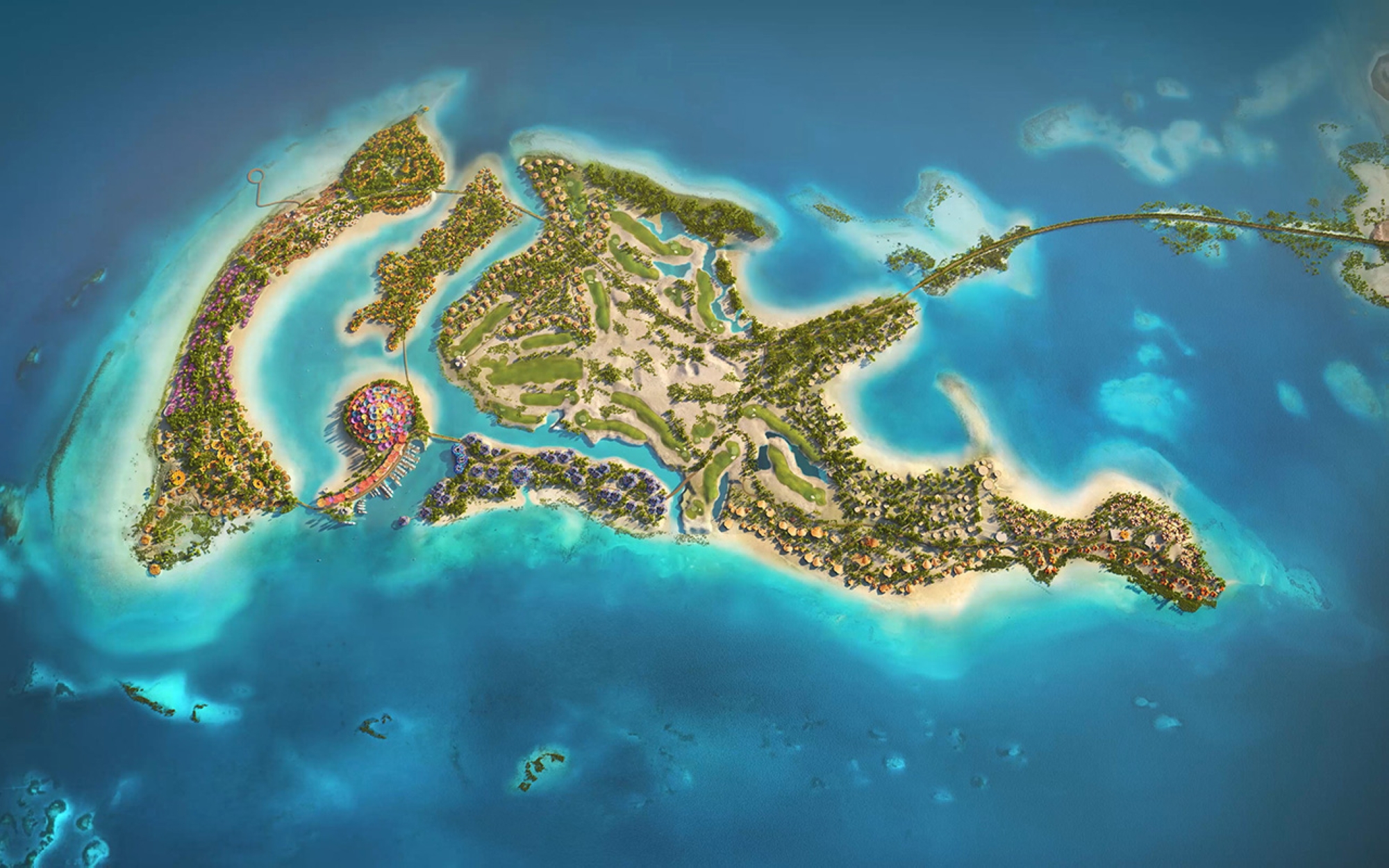
Plant diversity
The Kingdom exhibits a vast plant diversity across its diverse regions, providing suitable environments for a myriad of plant species. Approximately 2,100 plant species have been documented, including around thirty-five endemic species, constituting about 2 percent of the total plant species. Spatially, the distribution of plants is concentrated in the arid regions of the Kingdom, particularly in low-lying areas such as rawdat, valleys, and water courses where water accumulates after rainfall. Perennial plants, accounting for 35 to 40 percent of the desert species, are typically found in specific areas like the edges of rawdat, valleys, low depressions, and lands with sedimentation from floods and wind, characterized by deep soil. These plants also thrive in locations such as sand dunes and sabkha.
Valleys
Valleys are among the natural phenomena in the Kingdom, with hundreds of seasonal watercourses spreading over their surface, most of which occur during rainy periods. They are distributed throughout all its regions, but are less frequent in the southern part of the eastern region, and are absent in ar-Rub' al-Khali (Empty Quarter). The main streams in the Kingdom's provinces are called valleys (Wadi) and ravines. Tributaries' designations differ from one region to another.
Snow in Saudi Arabia
The snow season in the Kingdom marks one of the winter's manifestations. Snowfall occurs in specific regions, primarily in the northern regions, with temperatures varying across different areas. The northern regions experience the lowest temperatures.
Climate in Saudi Arabia
Due to the Kingdom's vast expanse and diverse topography, its climate exhibits variations from one region to another. Influenced by the tropical high pressure, the climate is characterized as continental, featuring hot summers and cold winters with rainfall occurring in the winter months. The western and southwestern highlands experience a moderate climate. In central regions, summers are hot and dry, while winters are cold and dry. Coastal areas witness elevated temperatures and humidity, with rainfall in the winter and spring. Most regions in the Kingdom experience limited rainfall, except for the southwestern highlands, which receive seasonal summer rains. The relative humidity is consistently high along the coasts and in the western highlands throughout most of the year, gradually decreasing as you move further inland.
Spring in the Kingdom spans from mid-March to mid-June. During this period, temperatures are relatively cool, particularly in the north, where nighttime temperatures can fall below fifteen degrees Celsius. In contrast, the central and southern regions experience milder temperatures, with nighttime averages around twenty degrees Celsius.
Summer in the Kingdom spans from mid-June to mid-September, except for the mountainous highlands in the Kingdom’s southwest, where temperatures remain moderate. This season commences with temperatures rising in most areas to approximately forty-five degrees Celsius. However, temperatures start to decline in the late night and early morning.
From mid-September to mid-December, the Kingdom experiences the fall season, characterized by a cool breeze that starts from the northern borders and the southwestern highlands. Despite daytime warmth, temperatures occasionally reach around thirty degrees Celsius at the season's outset. Winter spans the period from mid-December to mid-March in the Kingdom, characterized by chilly nights with average temperatures dropping below twenty degrees.
In the Kingdom, maximum temperatures vary by season: winter (December to February) sees temperatures ranging from twenty to thirty degrees Celsius; spring (March to May) ranges from thirty to forty degrees Celsius; summer (June to August) ranges from thirty-five to forty-five degrees Celsius; and fall (September to November) ranges from twenty-five to thirty-five degrees Celsius.
Water in Saudi Arabia
Rainwater serves as the main source of water resources within the Kingdom. Due to its scarcity, it is deemed deficient in water resources, especially with a significant portion lost to intense evaporation, limiting its full utilization. The other portion flows in valleys over a specific duration. Leaked water permeates into rock layers with suitable storage capacity. These layers, known as reservoir layers, house the seeping water, referred to as groundwater.
Water sources in the Kingdom are limited to specific types, including:
- Surface water: The water of the main valleys, the valleys with external drainage, and internal valleys.
- Groundwater: Subsurface groundwater and deep groundwater (geological layers carrying deep groundwater).
- Springs (Uyun).
- Wells (private and public).
- Desalinated fresh water (salt water desalination plants).
- Treated wastewater.
To harvest rainwater, numerous water traps have been placed in low-lying regions. These traps owe their existence to diverse factors, including the retreat of seawater from lands adjacent to the shores. They are prevalent within and around coastal areas, often originating from remnants of ancient lakes. Additionally, certain traps have emerged due to natural features like rocky ledges, sand dunes, and volcanic Harrat, intercepting rainwater streams.
There are various types and names for these traps, which differ based on their composition, type of soil, and permeability. Examples include traps with porous soil, suitable for cultivation and agriculture, such as al-Khabari, al-Rawdat, and al-Fayyad. Other examples encompass traps with non-porous soil, unsuitable for cultivation, like al-Qi'an, and those with saline soil, such as sabkha and salt mines.
Water traps in the Kingdom are more concentrated in the Arabian Plate (sedimentary cover) than in the Arabian-Nubian Shield. Water traps are divided according to their composition and type of soil including al-Khabari, al-Rawdat, al-Fayyad, al-Qi’an, sabkha, and al-Mamaleh (salt mines). Moreover, the southwest of the Kingdom includes six main basins: Wadi Najran, Wadi Hubuna, Wadi Tathlith, Wadi Bishah, Wadi Ranyah, and Wadi Turubah.
Education in the Kingdom of Saudi Arabia
Education in Saudi Arabia
Article Thirty of the Basic Law of Governance in the Kingdom states that the state is responsible for providing public education, fighting illiteracy, and instilling Islamic values in the youth while equipping them with knowledge and skills.
All male and female teachers in all levels of public education are required to have university degrees, with some holding advanced degrees such as master's or doctoral degrees. Each school is managed by a director and a deputy, supported by administrators who handle organizational tasks.
In 2020, the International Institute for Management Development (IMD) ranked the Kingdom Fourth globally in education spending. The Kingdom is home to approximately twenty-nine public universities, thirty-nine private universities and colleges, and about 36,000 public and private schools.
In the Kingdom, public education at all levels is free for citizens and residents in public schools, and university education is also free for citizens, except for a few paid programs. Textbooks are provided at no cost to public school students, and university students receive monthly stipends for the duration specified in their program.
Students in the Kingdom have the opportunity to select their educational paths from a young age. They can choose from public schools, Quran memorization schools, specialized scientific institutes, vocational training centers, and technical and sports institutes.
Saudi schools offer a diverse range of curricula, including natural sciences, mathematics, languages such as Chinese and English, and religious studies including Quranic subjects.
Beyond academics, schools provide transportation and health care services. The state also supports education for individuals with special needs through specialized schools and educational centers, and offers enrichment programs for gifted and talented students.
Educational achievements in Saudi Arabia
The Kingdom continues to advance education to meet the goals of Saudi Vision 2030 and elevate the quality of its educational processes. During the COVID-19 crisis, the country successfully implemented distance education through digital platforms and channels, launching numerous development initiatives. It also encouraged private sector investment in educational facilities, allowing for the construction of schools based on the (BMT) model. Additionally, new special education centers have been established in several cities, approximately seventy early intervention programs have been introduced in government kindergartens, and specialized educational classes have been created to support male and female students with tumors.
The Ministry of Education has rolled out several development programs and initiatives, including the National Program for Gifted Identification, the National Olympiad for Scientific Creativity, and an acceleration system to advance students to higher grades more quickly.
The Kingdom also emphasizes research, innovation, development, and scientific publishing, with its male and female students earning numerous awards at international forums.
Culture in Saudi Arabia
Traditional dances in Saudi Arabia
The Kingdom has traditional dances, many of which originated from the challenging conditions or wartime experiences of past generations. These dances have been handed down through generations, evolving into a significant cultural and artistic symbol for various Saudi cities and provinces. Among these traditional dances in the Kingdom:
The Saudi Ardah: locally referred to as the Najdi Ardah, is a dance that has been practiced in the Najd region since the time of Founding King Abdulaziz Bin Abdulrahman Al Saud. He is credited with formalizing its structure and regularly performed it with his men and citizens during occasions such as Eid al-Fitr and before the onset of battle, as a display of courage and preparedness.
Al-Zamil: This ancient traditional dance is renowned in Aseer Province and is now performed by many southern tribes. It is accompanied by singing various poems suited to different occasions. Al-Zamil is a collective dance performed in a unified manner during events such as wars and peace, disasters, harvest seasons, house building, marriages, circumcisions, problem-solving, requests for help, and other significant occasions.
Al-Khubaity: An ancient traditional art originating from Makkah al-Mukarramah and al-Madinah al-Munawwarah Provinces, al-Khubaity has become popular across the Kingdom's provinces. It is commonly performed at weddings and folk festivals. This art form features improvised poems, diverse melodies, and is accompanied by drums and the simsimiyya instrument. A group of dancers performs in harmony with the rhythm, incorporating spinning and bending movements.
Al-Daha: It is a traditional dance widely recognized in the northern regions of the Kingdom. Originally linked to wars, victories, and instilling fear in adversaries, it has since evolved into a celebrated cultural heritage performed at national festivals both within and outside the Kingdom. This art form relies on group performance and features sung poems with themes of love, praise, and pride.
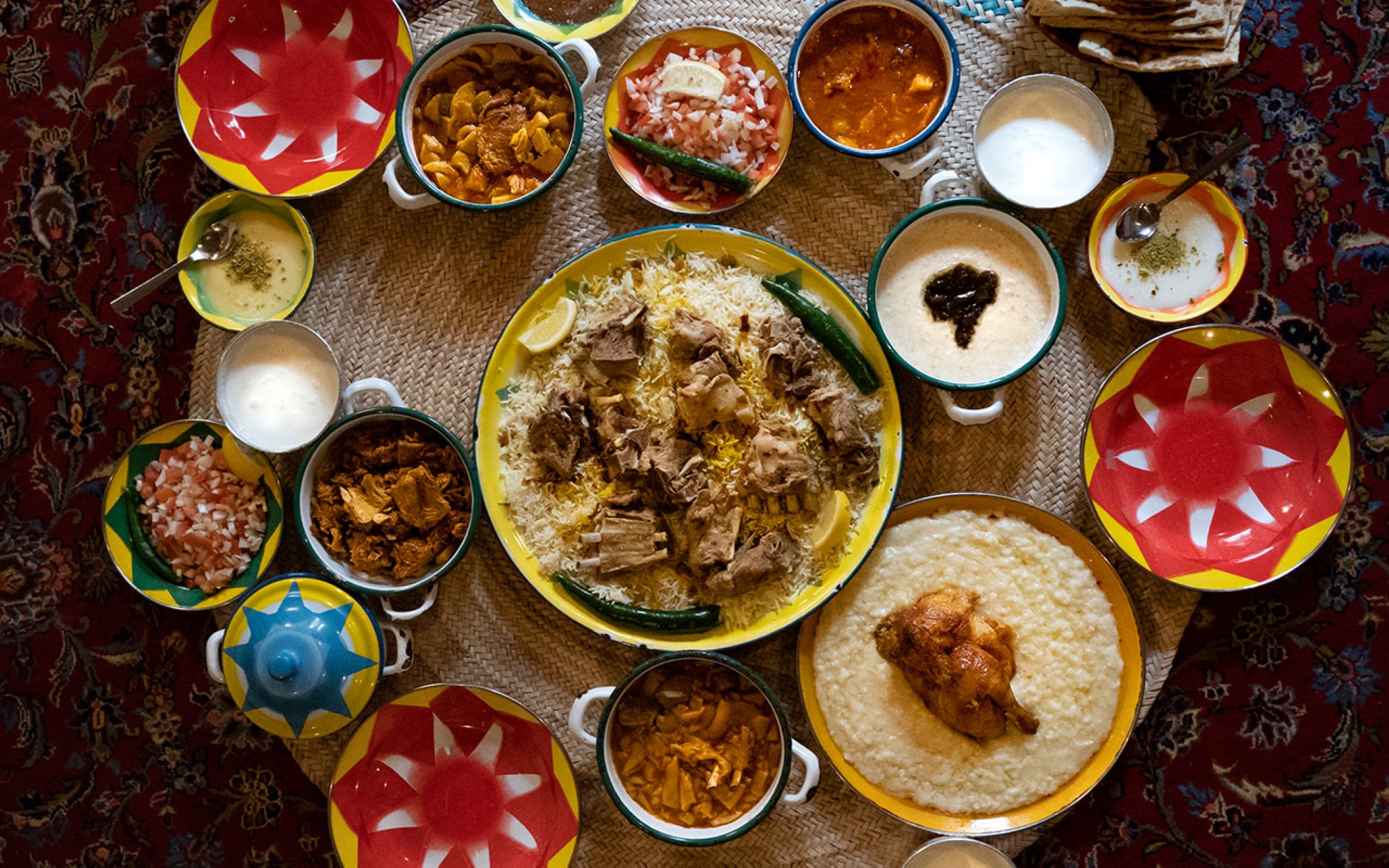
Eating habits in Saudi Arabia
Eating habits in the Kingdom are deeply rooted in traditional practices that reflect Arab, Islamic, and cultural values. These habits are passed down through generations and are prevalent in both daily meals and formal occasions.
Certain Arab and Islamic etiquettes influence eating behaviors, especially in formal settings, and are shared across the Kingdom and the Gulf States due to their common cultural and linguistic heritage.
A tradition in the Kingdom is to begin a meal by saying "Bismillah" (In the name of Allah) and to conclude with "Alhamdulillah" (Praise be to Allah). These expressions of gratitude for Allah are integral to the meal. The term “food” is often used, along with its synonym “al-Na’mah” (the blessing), which conveys a deeper sense of appreciation.
During formal meals, it is customary for the host to encourage the guest to begin eating with phrases like “Eqlat” or “Tamm 'ala 'Ashak.” After the meal, it is polite for the guest to express their appreciation for the food and the host, typically using the phrase “Kathar Allah Khairkum” (May Allah grant you more blessings).
Saudi food culture often involves everyone gathering around a single table on the floor, eating the main meals with their hands and using only the right hand. It is considered improper to pick and choose ingredients from the food or to eat only from one part of the plate; instead, one should eat from the side closest to them. The host or person who prepared the food is expected to assist by cutting the meat and serving it, as well as ensuring that portions are adequate. Additionally, they encourage children to eat with their hands and to finish the last bits of food on their plate, known locally as “Luqmat al-Mustihi".
The behavior of eating while sitting is preferred among Saudis over eating while walking. Restaurants in the Kingdom generally feature a modern style similar to those found globally. However, many Saudi establishments offer traditional Arabic seating arrangements for those who enjoy popular local cuisine.
Saudi traditional garments
Fashion across Saudi provinces tends to share common elements, whether in garment names, fabric types, or styles.
Saudi women from all social settings commonly wear the Abaya, which is a staple garment for leaving the house. There are various styles, including the regular Abaya, the shoulder Abaya (with or without embellishments), and the loose head Abaya.
In addition to the Abaya, Saudi women also wear head coverings such as the hijab, shayla, burqa, or niqab. While not legally mandated, these garments are preferred for modesty, and women are free to choose other clothing as long as it remains modest and does not feature images, symbols, or phrases that might be deemed offensive.
Men's clothing in most Saudi provinces typically includes the Thobe. The traditional Saudi garment consists of several components: the Thobe, the Shemagh or white Ghutra, the Taqiyah, and the Agal. For formal occasions, a Bisht may also be worn.
Hospitality in Saudi Arabia
Hospitality is rooted in Arab and Islamic traditions, exemplified by the values upheld by Saudi society. It is a cherished virtue, with individuals taking pride in providing exceptional hospitality and entertainment to their guests, whether they are expected visitors or strangers arriving for the first time. In Saudi culture, anyone who arrives unannounced is treated as a guest. This principle extends to the official reception of pilgrims and Umrah performers, who are welcomed under the designation "Guests of the Most Merciful".
Tourists in the Kingdom can experience this hospitality firsthand, often encountering locals who go out of their way to host them without expecting anything in return. Residents treat every guest, regardless of their familiarity, with the same warmth and friendliness as a friend or acquaintance. Traditionally, Saudi hospitality begins with offering Saudi coffee and culminates in a meal, which may sometimes be a feast, typically including one or both of the main meals, lunch or dinner.
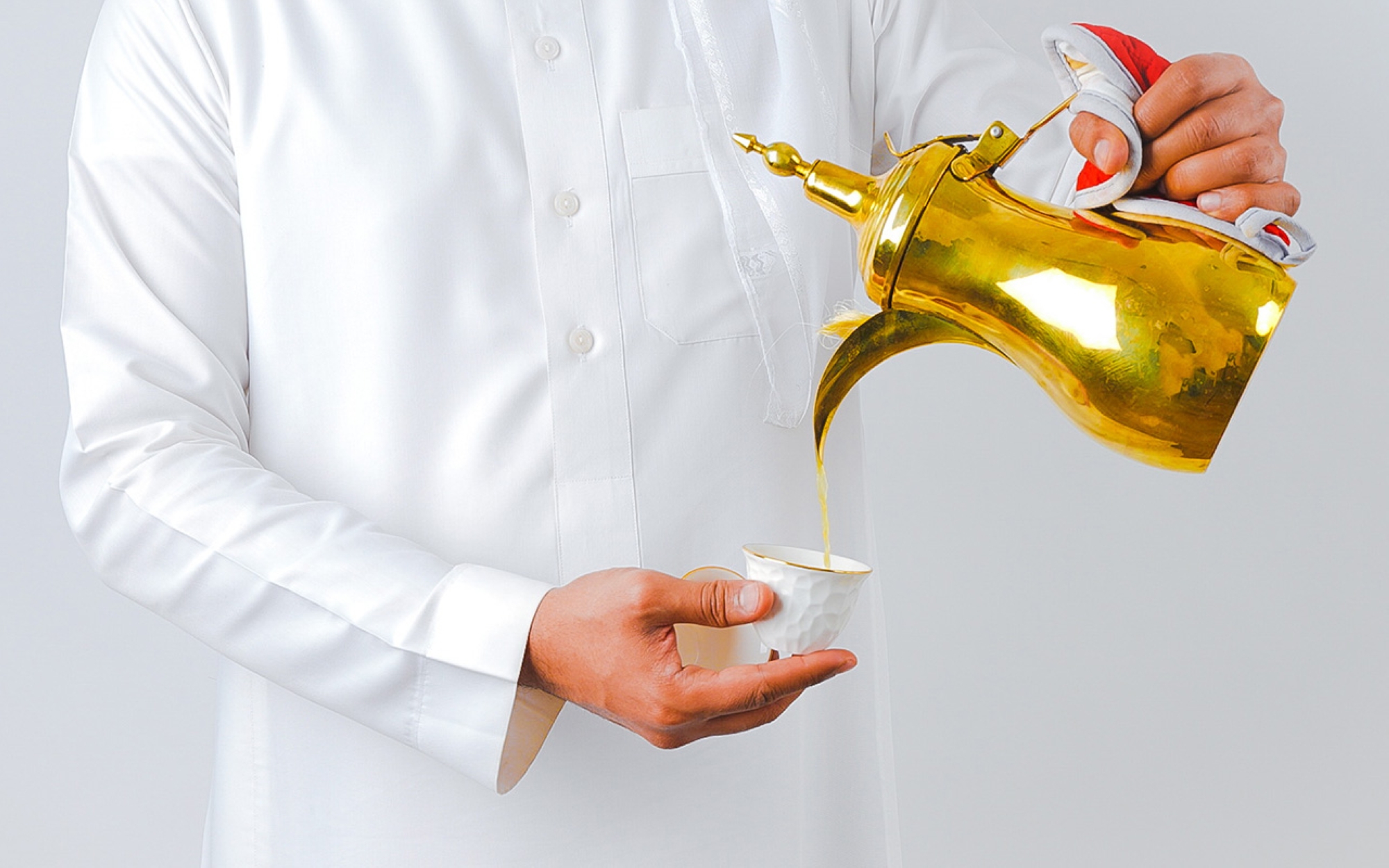
Saudi coffee
Saudi coffee is a symbol of hospitality and a vital part of Saudi culture and heritage. The preparation and serving methods vary across the provinces of the Kingdom, influenced by the surrounding environment. Saudi coffee was inscribed on the UNESCO list of intangible cultural heritage as 'Arabic coffee, a symbol of generosity', reflecting its shared importance among the Kingdom and several Gulf countries.
When serving coffee, a host traditionally holds the coffee pot in their left hand and carries three to four cups in their right. It is customary for the host to sample the coffee before offering it to guests to ensure its quality, and the host remains standing until all guests have finished their coffee.
UNESCO’s intangible cultural heritage
UNESCO’s intangible cultural heritage encompasses traditions, oral expressions, performances, arts, social practices, rituals, celebrations, knowledge about the universe and nature, and traditional arts and crafts. The Kingdom's unique intangible heritage includes three elements recognized by UNESCO: the Saudi (Najdi) Ardah, al-Mezmar dance, and al-Qatt al-Asiri art. Additionally, the Kingdom shares five registered heritage elements with other countries: al-Majlis, Arabic coffee, falconry, date palms, and Sadu weaving.
Theater in Saudi Arabia
The beginnings of theater in Saudi Arabia
Playwriting in the Kingdom began in 1932, alongside early efforts to establish Saudi theater. During the 1970s and 1980s, the Ministry of Knowledge (now the Ministry of Education) incorporated theater into its activities, contributing to the growth of theater in the Kingdom. However, by the 1990s, theatrical activity had largely vanished from most Saudi provinces, though it continued to be present in Arab and regional forums. The Saudi Arabian Society for Culture and Arts supported local theater artists, and theater festivals helped revitalize the field, even as many of these festivals ceased.
With the changes introduced by Saudi Vision 2030, the number of theatrical performances has increased significantly, thanks to commercial theatre and the support of the General Entertainment Authority. In 2019, data from attendance figures and cultural participation surveys highlighted a growing demand for theatrical performances. To advance the theatre sector in the Kingdom, the Ministry of Culture established the Theatre and Performing Arts Commission and founded the National Theater. Additionally, to train professional talent in the theater industry, the ministry included theater specializations as part of the cultural scholarship program.
Theater and Performing Arts Commission
The Theater and Performing Arts Commission, founded in 2020, focuses on a wide range of performing arts, including theater, circus acts, dance, improvisational comedy, movement performances, street shows, opera, and ballet. Its mission includes revitalizing theaters, ensuring high-quality content, promoting increased production, and fostering a deep appreciation for the performing arts as a fundamental part of national culture.
Music in Saudi Arabia
The Saudi song
Modern Saudi singing art began to take shape in the 1950s and 1960s, when a generation of artists mastered both local musical traditions and evolving Arab singing styles. Institutions played a crucial role in nurturing this art form through musical bands on television and radio, as well as the Saudi Army Music School. Despite the limited institutional support at the time, the music scene continued to flourish with a distinctive Saudi character that eventually spread across the Arab world, while popular singing thrived in social circles.
In recent years, the music sector in the Kingdom has experienced a significant transformation. Public institutions have celebrated Saudi music and all Saudi singing arts by organizing international classical concerts, cultural events showcasing folklore bands, and entertainment parties across various regions. As a result, music has become an integral part of the cultural fabric of Saudi cities and provinces.
The Saudi music scene has also seen the rise of amateur musicians and youth groups who independently pursue their craft, often through self-education and experimentation. These artists perform privately or in public venues such as cafes and restaurants, and popular singing has gained official recognition, becoming a fixture in national festivals and social events.
However, the song industry in the Kingdom has faced challenges, including a shortage of music production companies and a lack of educational infrastructure. In response to the high demand for live performances and recordings, coupled with a growing interest in music education and abundant talent, the Ministry of Culture established the Music Commission and included music specializations in its cultural scholarship program. These efforts aim to revive and enhance the music industry in the Kingdom.
Music Commission
The Music Commission, founded in 2020, was established to develop the infrastructure for musical culture in the Kingdom. Its mission includes providing opportunities for music education, empowering musical talents, and promoting music within society. The commission aims to establish a sector that contributes to the local economy by creating job opportunities, overseeing the production and governance of cultural performances, and supporting music education centers. Additionally, it focuses on music recording, the documentation and revival of Saudi music and folklore, and the development of the Kingdom’s musical cultural identity, with the goal of sharing it both regionally and globally.
Transportation in Saudi Arabia
The Kingdom spans approximately two million km, making it the fourth-largest country in Asia by area. To connect its vast territory, the Kingdom has placed emphasis on the movement of goods and passengers. The total length of roads in the Kingdom is estimated at around 228,000 km, including approximately 66,000 km of highways. The longest road stretches 820 km, connecting Makkah al-Mukarramah to the capital, Riyadh.
The Kingdom hosts several international airports that link it to global destinations, including King Abdulaziz International Airport in Jeddah, King Khalid International Airport in Riyadh, King Fahd International Airport in Dammam, Prince Mohammed Bin Abdulaziz Airport in al-Madinah al-Munawwarah, Prince Naif Bin Abdulaziz Airport in Qassim, Abha International Airport, Taif International Airport, Neom International Airport, and Red Sea International Airport. In addition to these, domestic airports connect Saudi cities. The Kingdom also operates three railways, totaling around 3,650 km and spanning six administrative provinces. The country manages key global maritime and commercial routes, and it boasts nine ports, forming the largest maritime transport network in the Middle East. Highlighting its focus on land routes, the Kingdom has prioritized road connections with neighboring countries, including the King Fahd Causeway, which links the Kingdom to the Kingdom of Bahrain.
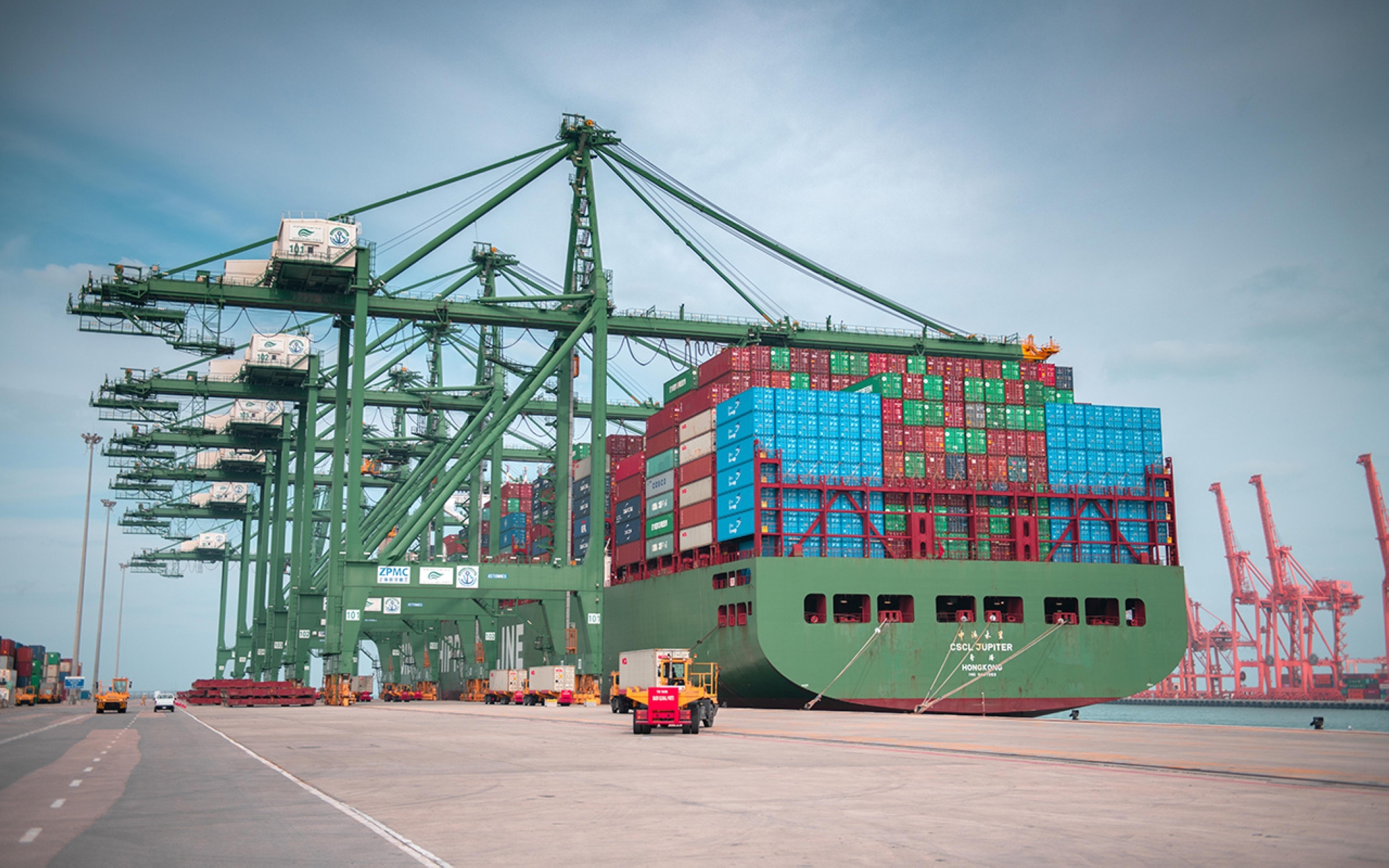
Tourism in the Kingdom of Saudi Arabia
Tourism in Saudi Arabia
The tourism sector in the Kingdom plays a role in supporting and diversifying the national economy. It aims to attract investments, increase income levels, and create job opportunities. This sector operates under a unified framework, encompassing the Ministry of Tourism, the Tourism Development Fund, and the Saudi Tourism Authority.
Festivals and events in Saudi Arabia
The Kingdom has experienced rapid growth and development in the cultural events and festivals sector, driven by collaboration between various government institutions, sectors, and the private sector. Companies specializing in event organization and talent management have played a role in this development. Following the launch of Saudi Vision 2030, the sector has been further refined, with major national festivals being managed by more specialized entities. The introduction of the "Saudi Seasons" program has also been instrumental in promoting domestic tourism, offering events and festivals tailored to specific Saudi provinces within set timeframes.
Local communities have played an active role in reviving long-dormant festivals and events, while civil and non-profit organizations have contributed by hosting cultural activities and festivals, as well as artistic and educational programs for the public.
International events have also helped draw large audiences in the Kingdom, foster investment, enhance administrative capabilities, develop local expertise, and create job opportunities for the youth, particularly in organizing and managing events and festivals.
Tourist visa in Saudi Arabia
Entry visas to the Kingdom were previously restricted to specific purposes, such as Hajj and Umrah, employment, diplomatic missions, visits, medical treatment, and education. However, on September 27, 2019, the Kingdom introduced a tourist visa, allowing visitors from around the world to explore the country for up to ninety days.
Sport in the Kingdom of Saudi Arabia
Sport in Saudi Arabia
The Kingdom focuses on organizing a wide range of sports and activities, both individual and team-based, within a national framework, including local competitions and leagues. It also hosts international sporting events and actively encourages athletes to participate, while motivating the public to attend and engage with these events.
Examples of sporting events in Saudi Arabia
Sporting events, particularly football, attract a vast fan base, with clubs competing in several major tournaments, including the Roshn Professional League, Custodian of the Two Holy Mosques Cup, Saudi Super Cup, First Division League, and the Saudi Second Division League.
Women's football competitions are also held, with the Women's Football League held in Riyadh, Dammam, and Jeddah. These events are organized by the Saudi Sports for All Federation in collaboration with the Ministry of Sport and the Quality of Life Program. Teams must have at least fourteen players, and participation is open to women aged seventeen and older.
The Kingdom became a member of the Fédération Internationale de Football Association (FIFA) in 1956, after the Saudi Arabian Football Federation officially signed the FIFA membership agreement.
The Kingdom hosts a variety of competitions and events in various sports, including organizing international sports events and competitions that draw spectators and enthusiasts from around the globe. These include Formula E races, the Dakar Rally, Formula One races, Extreme E, wrestling events, the Diriyah Tennis Cup, basketball championships, the Diriyah Equestrian Festival, the Jeddah International Speed Chess Championship, the Formula 1 Powerboat World Championship, the Red Sea Sport Fishing Championship, and the Free Skydiving Championship.
National teams in Saudi Arabia
The Kingdom has a number of national teams that represent the country in international competitions and tournaments. These include the senior national team, the Olympic team, the youth teams, the junior teams, the cadet teams, the futsal team, as well as the beach soccer team. The senior national football team has participated in the World Cup, the Asian Cup, the Arab Cup, and the Gulf Cup. The Kingdom won the AFC Asian Cup three times in the years 1984, 1988, and 1996.
Sports facilities in Saudi Arabia
The Kingdom boasts a variety of sports facilities spread throughout its cities and governorates, including three major sports halls located in Riyadh, Jeddah, and Dammam. It features seventeen sports cities, such as King Abdulaziz Sports City in Makkah al-Mukarramah City, King Abdullah Sports City in Jeddah Governorate, King Fahd Sports City in Riyadh, King Saud Sports City in al-Bahah, Prince Mohammed Bin Abdulaziz City in al-Madinah al-Munawwarah, and Prince Sultan Bin Abdulaziz Sports City in Abha City. Additionally, there are approximately thirty-six sports stadiums across various cities and governorates, including King Saud University Stadium (al-Awwal Park) in Riyadh, al-Shabab Club Stadium in Riyadh, Kingdom Arena Stadium in Riyadh, al-Ahli Club Stadium in Jeddah, and Prince Abdullah Bin Jalawi Sports City Stadium in al-Ahsa.
Sports clubs in Saudi Arabia
There are an estimated 171 sports clubs in the Kingdom, each focusing on either a single sport or multiple sports. The oldest of these in the Kingdom is al-Ittihad Club in Jeddah Governorate, established in 1927. Following its founding, other notable clubs emerged, including al-Ahli Saudi Club in 1937 and al-Ettifaq FC in 1945.
Saudi Arabia globally
Middle East Green Initiative Summit
To address climate change in the region, His Royal Highness Prince Mohammed Bin Salman Bin Abdulaziz Al Saud, crown prince and prime minister, inaugurated the inaugural Middle East Green Initiative Summit in the capital, Riyadh, on October 25, 2021. The summit, which brought together representatives from approximately twenty-eight countries, focused on regional climate issues and fostered a collective effort to tackle climate change.
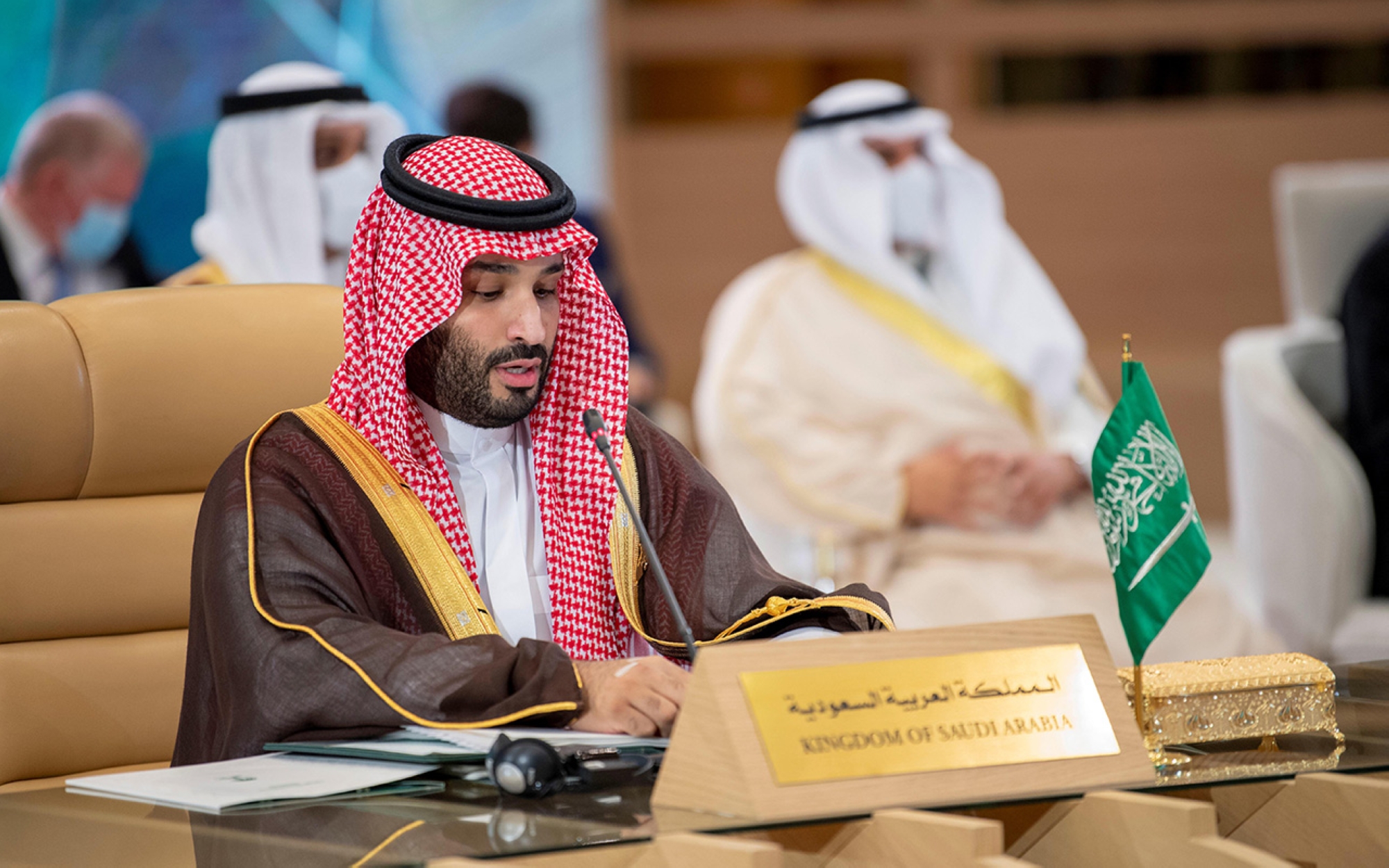
Saudi Arabia's hosting of G20
The Kingdom hosted the G20 Leaders Summit in Riyadh City, led by the Custodian of the Two Holy Mosques King Salman Bin Abdulaziz Al Saud. Due to the global COVID-19 pandemic, the summit was held virtually. The meetings began under the Kingdom's presidency on December 1, 2019, and continued until the leaders’ summit took place in Riyadh in November 21-22, 2020. The summit was guided by the theme “Realizing Opportunities of the Twenty-First Century For All” focusing on three main areas: Empowering People, Preserving the Planet, and Shaping New Horizons.
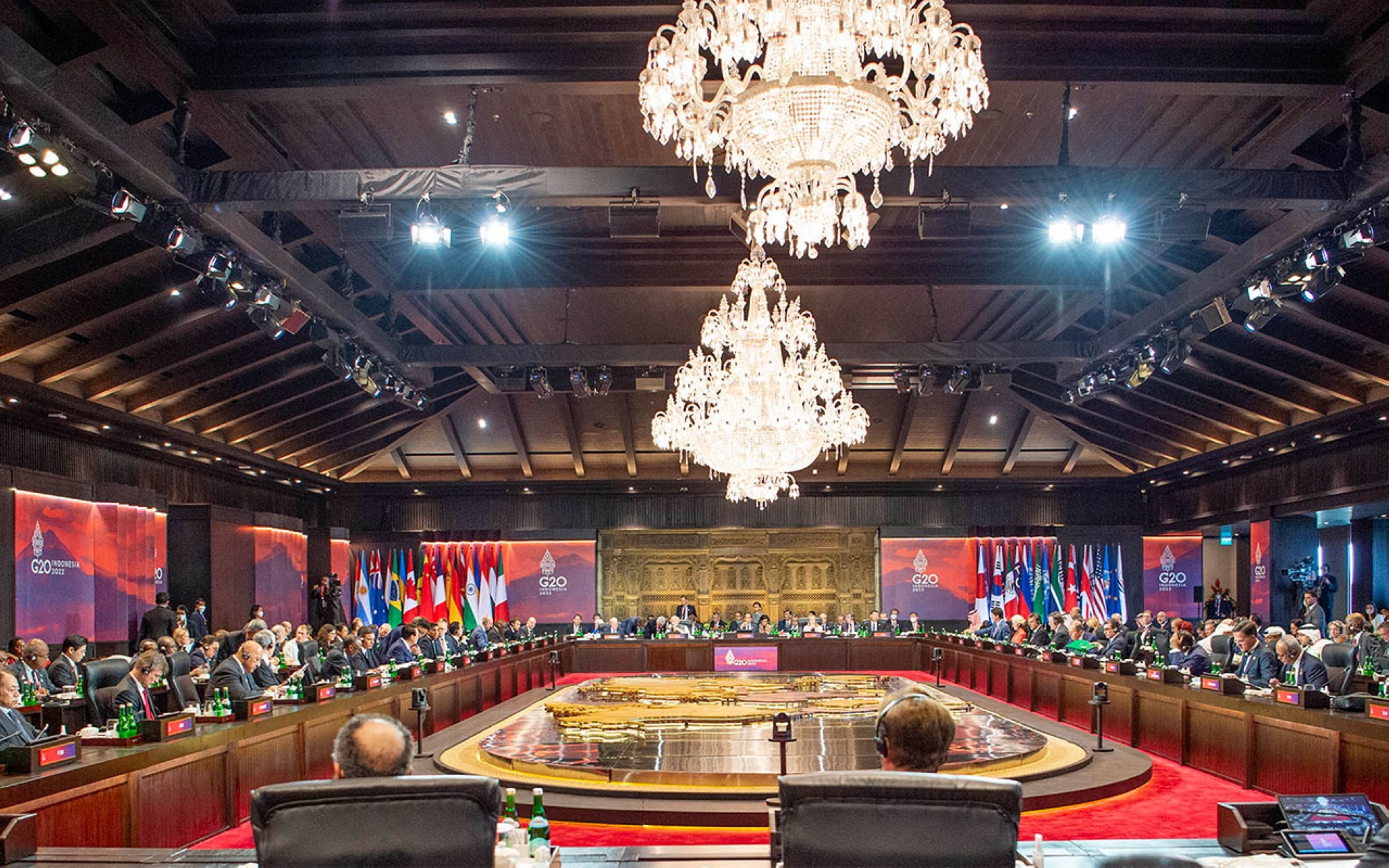
Official Holidays in Saudi Arabia
These are dates specified by the Saudi calendar and apply to government departments, institutions, and the private sector. These holidays include:
National Day holiday
It takes place on September 23 each year and is recognized as an official holiday by Royal Order to commemorate the anniversary of the announcement of the Kingdom's unification.
Founding Day holiday
It has been designated on February 22 of each year, an official holiday commemorating the founding of the Kingdom.
Weekend
In the Kingdom, the weekend is observed on Friday and Saturday.
Eid al-Fitr and Eid al-Adha holidays
The Eid al-Fitr holiday, according to the Hijri calendar, begins from 25 Ramadan to 5 Shawwal, lasting approximately ten days to two weeks. The Eid al-Adha holiday, also called Eid al-Hajj, begins from 5 to 15 Dhu al-Hijjah.
National events in Saudi Arabia
Saudi National Day
It is the annual commemoration of the proclamation of the unification of the Kingdom of Saudi Arabia. It is an official holiday, marking the first day of Libra at the beginning of the Solar Hijri Year. It coincides with September 23 of the calendar year.
Saudi Founding Day
It is a national occasion in the Kingdom, commemorating the founding of the First Saudi State in 1727 by Imam Mohammed Bin Saud. It was approved by a Royal Order issued on January 27, 2022. February 22 of each year is designated as Saudi Founding Day and an official holiday.
Saudi Flag Day
It is a day dedicated to the flag. The Kingdom celebrates its flag on March 11 of each year. This stems from the value of the national flag, which has extended throughout the history of the Saudi state since its founding. This day was approved by a Royal Order issued on March 1, 2023.
Related quizzes
Related articles

